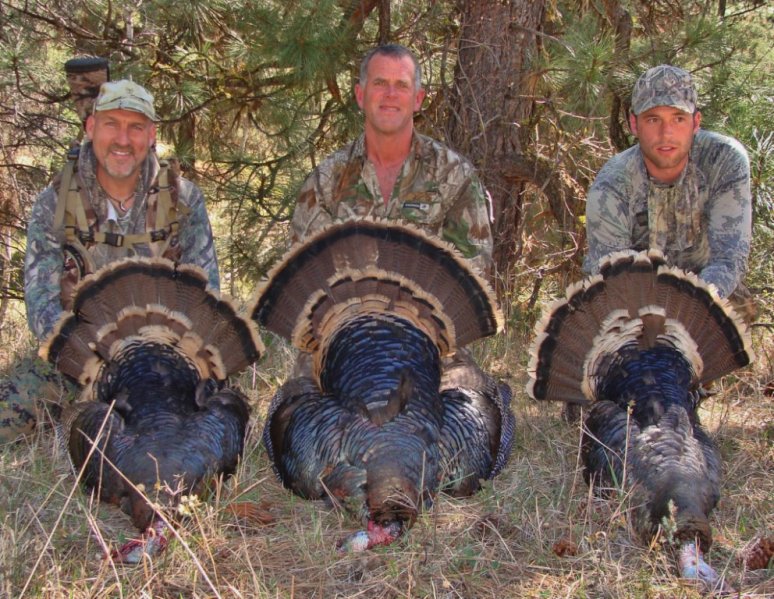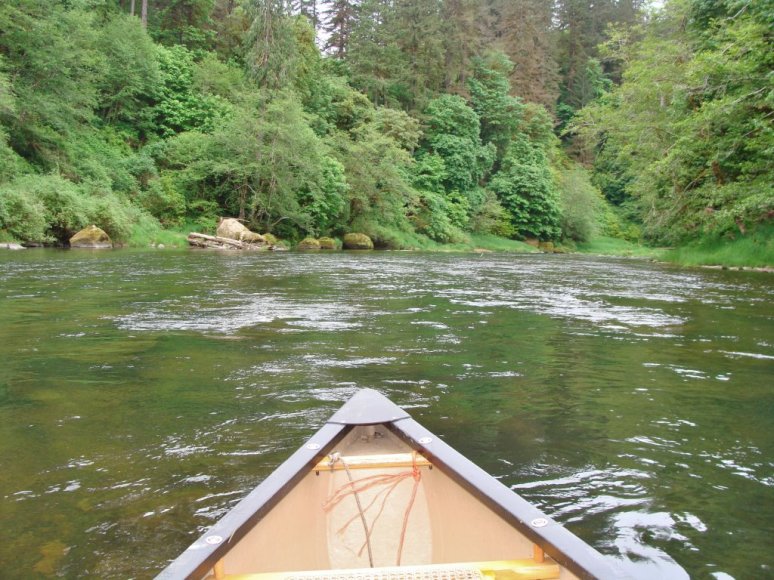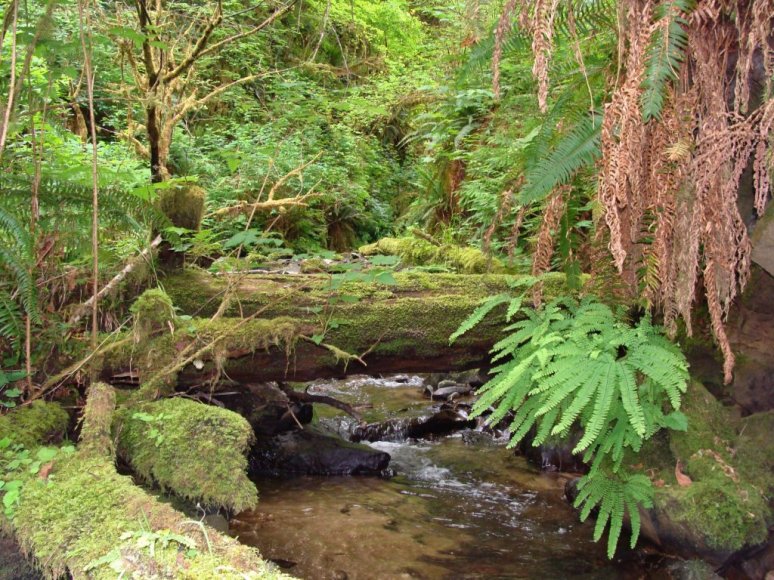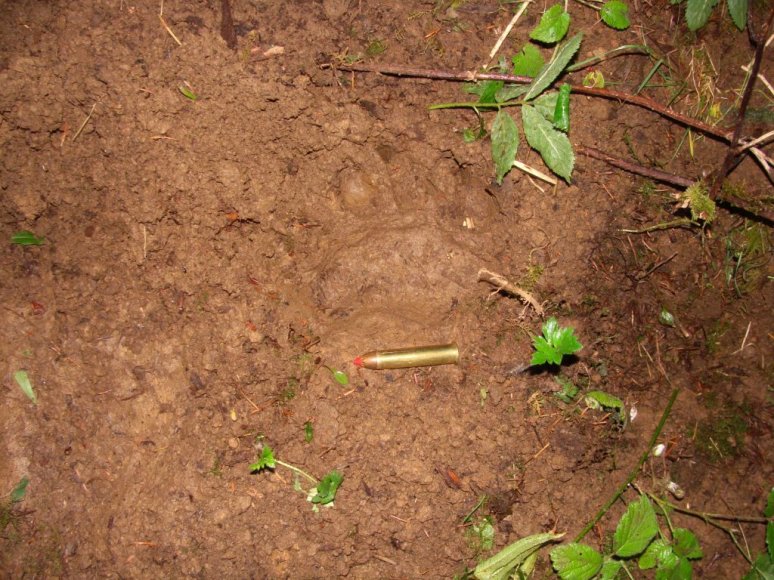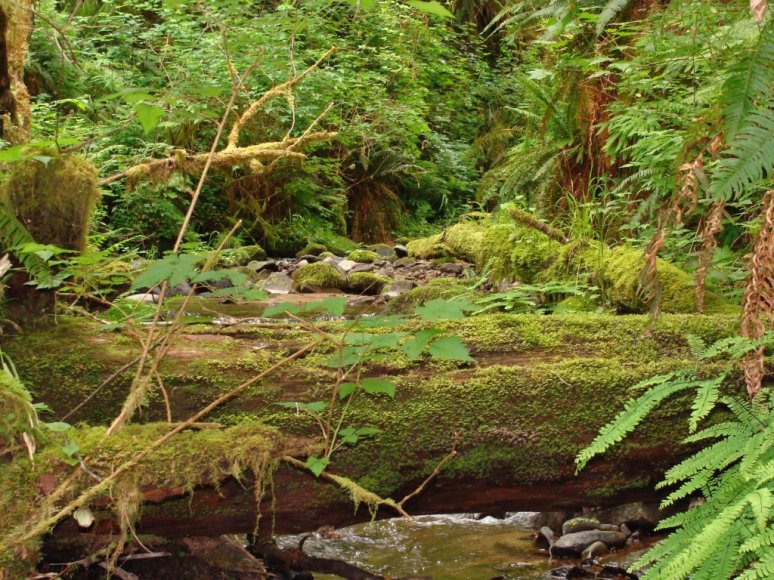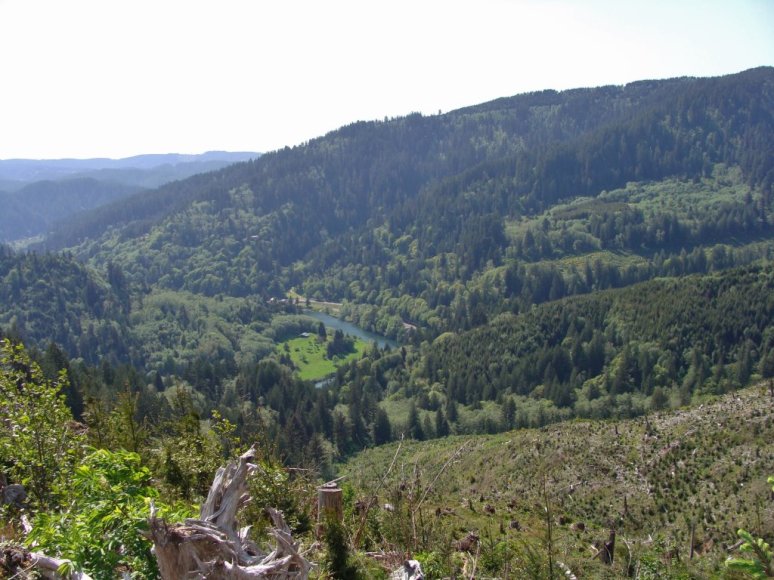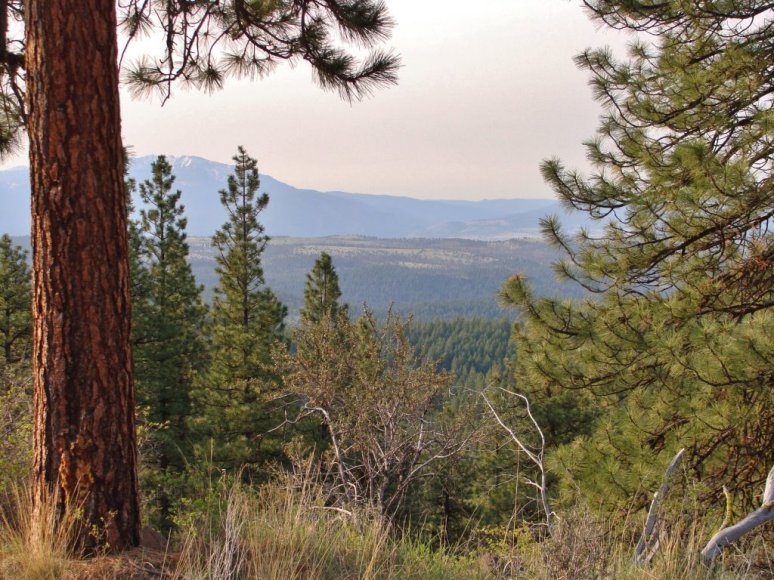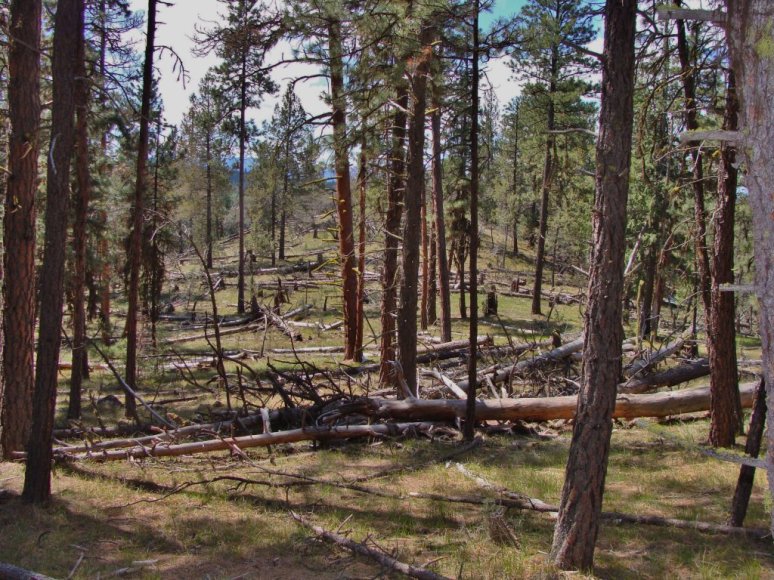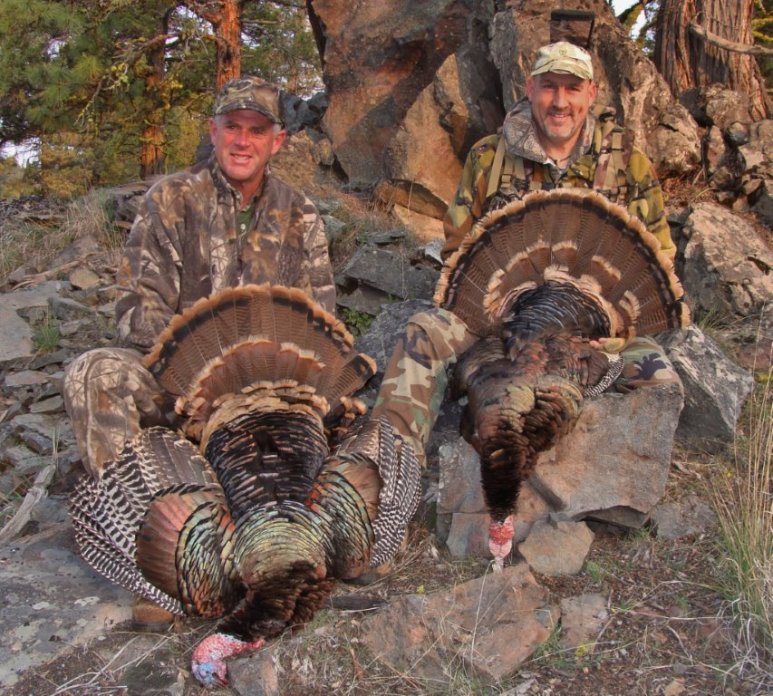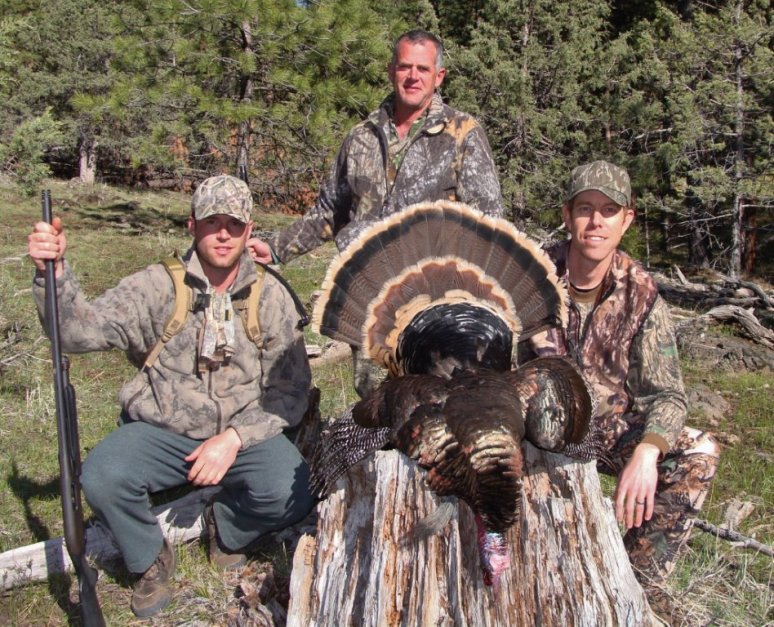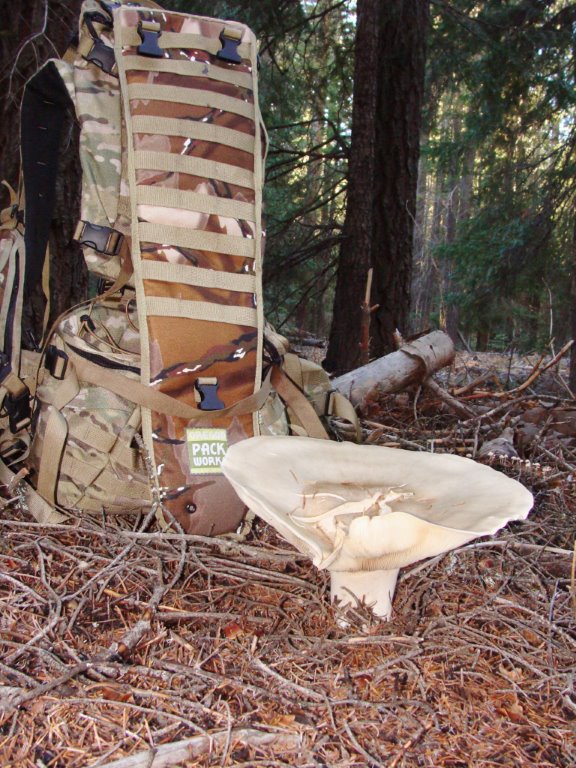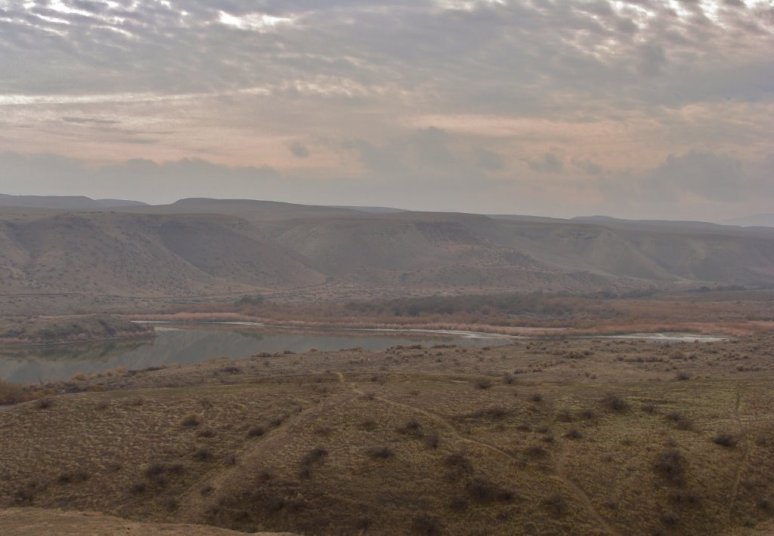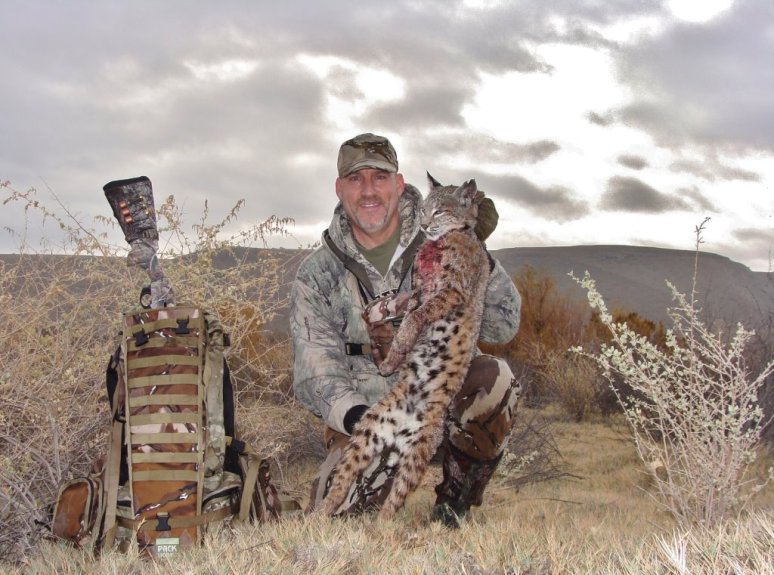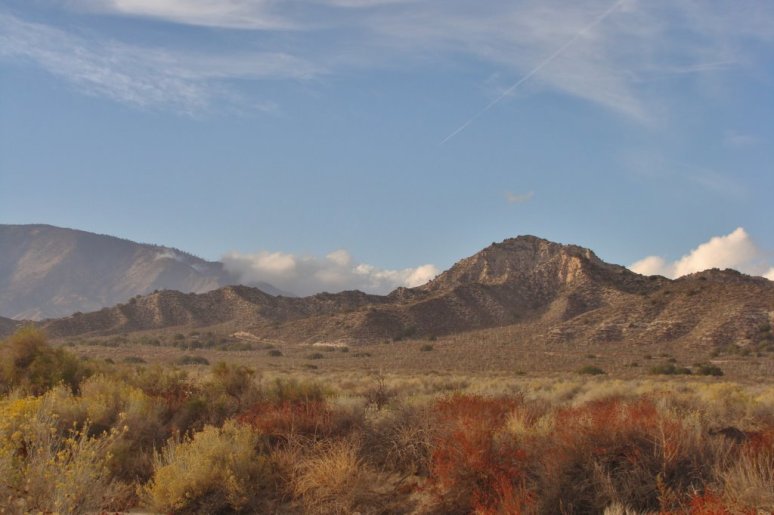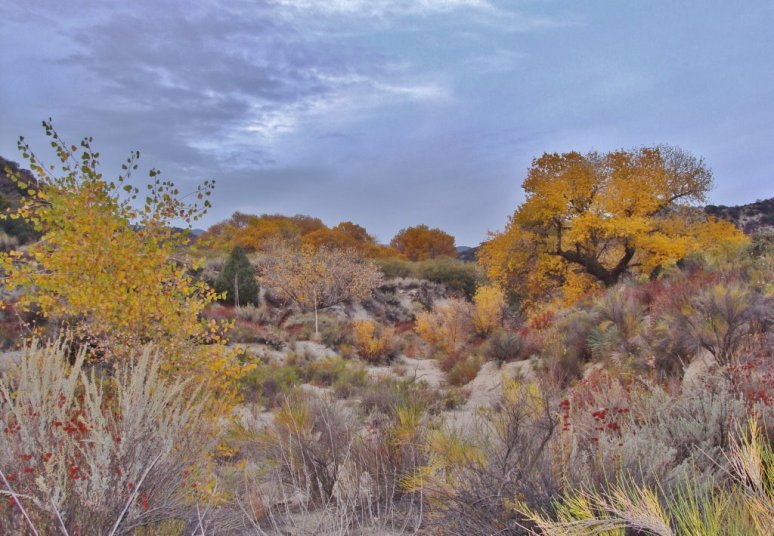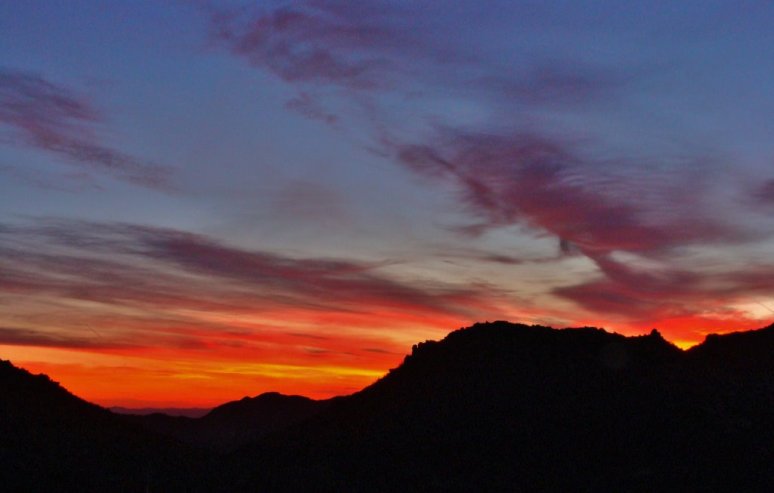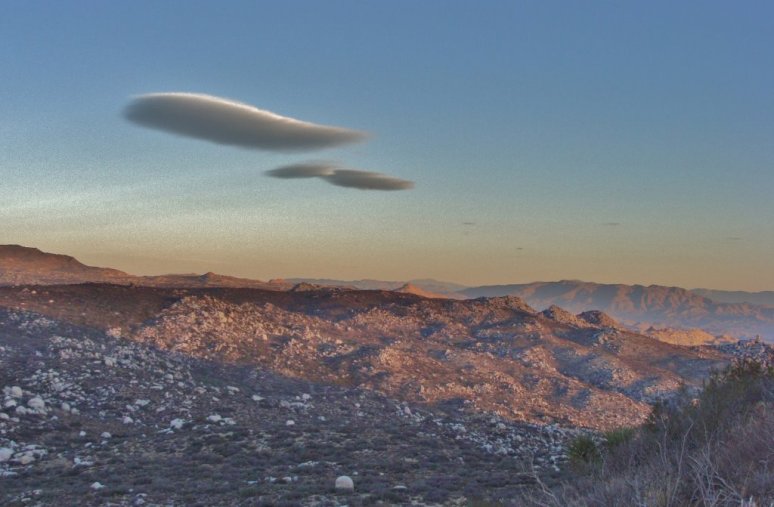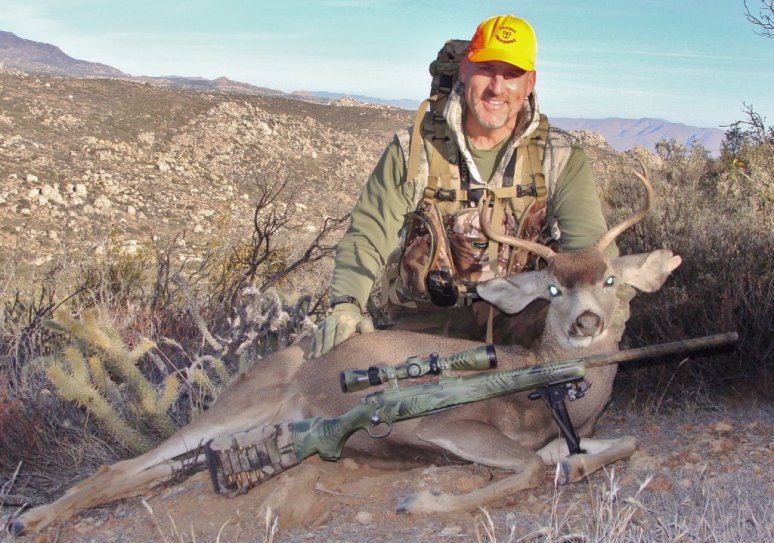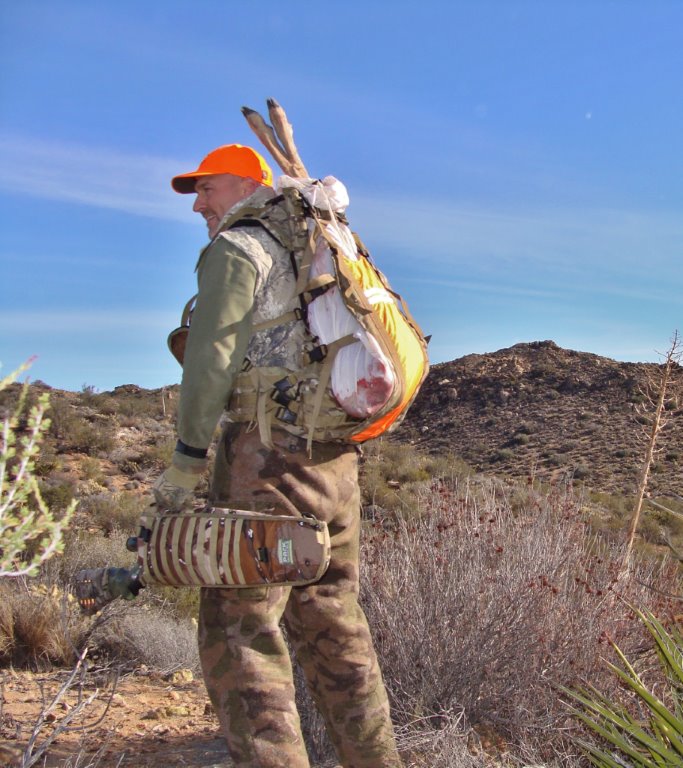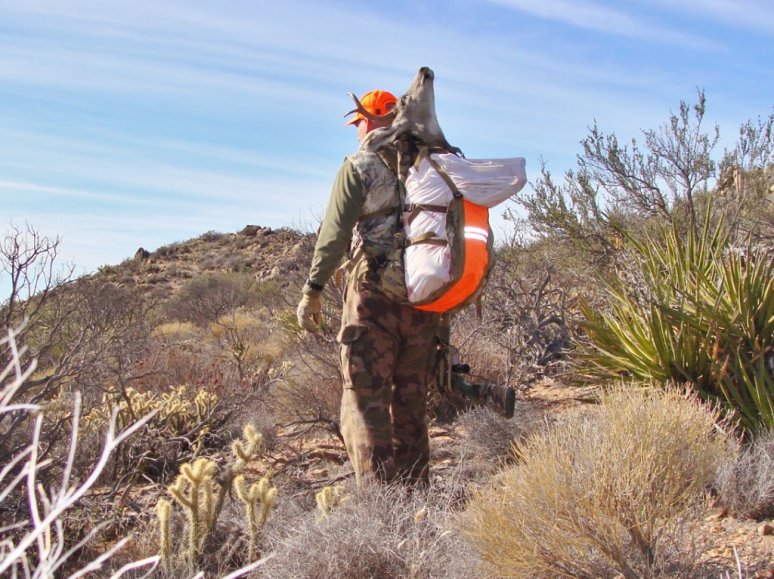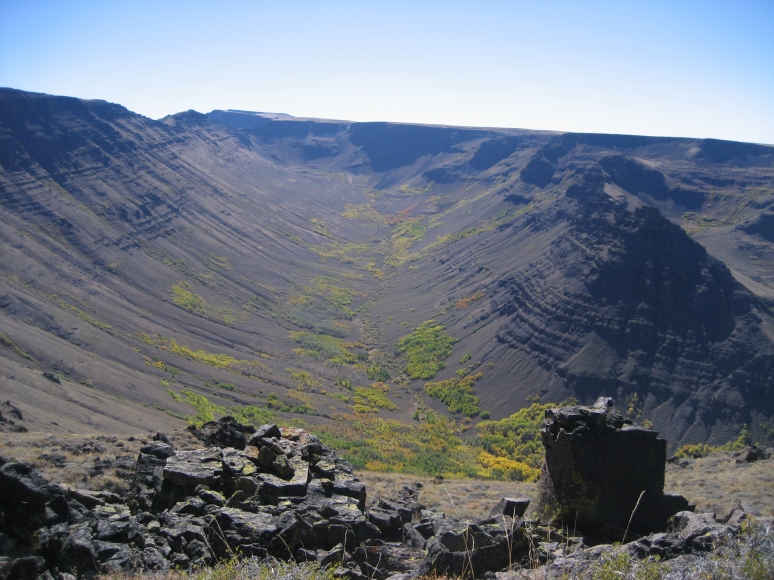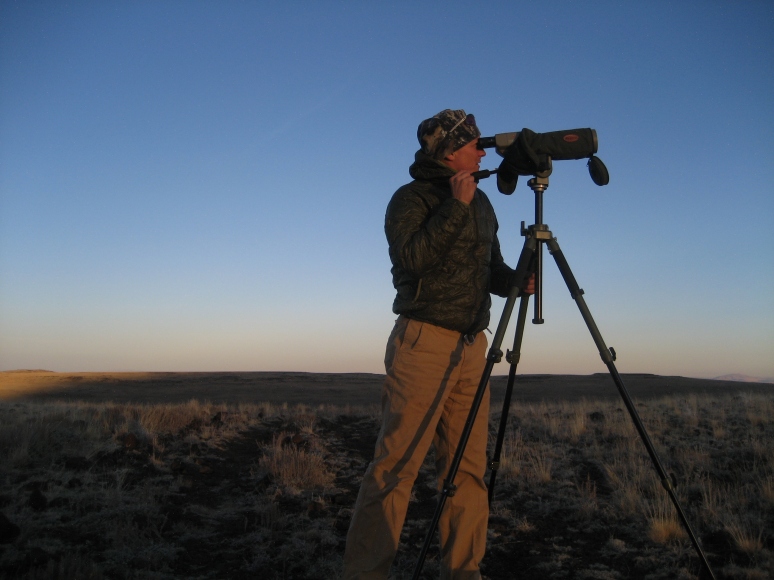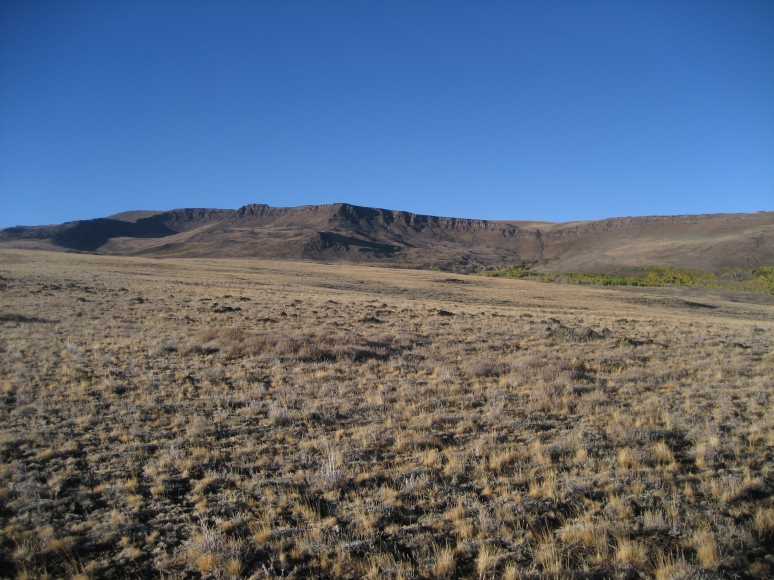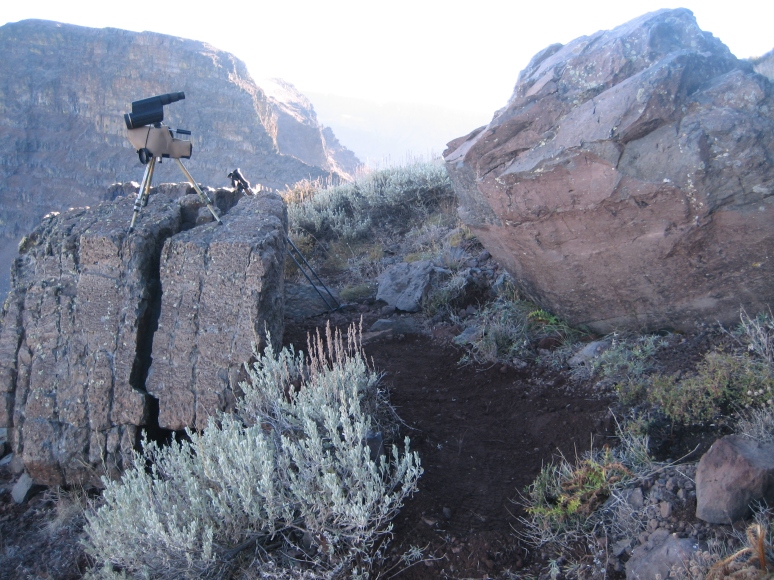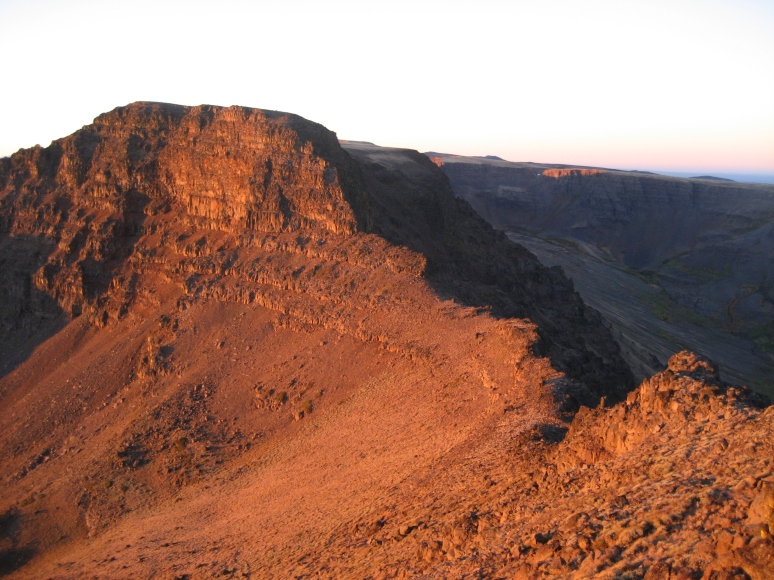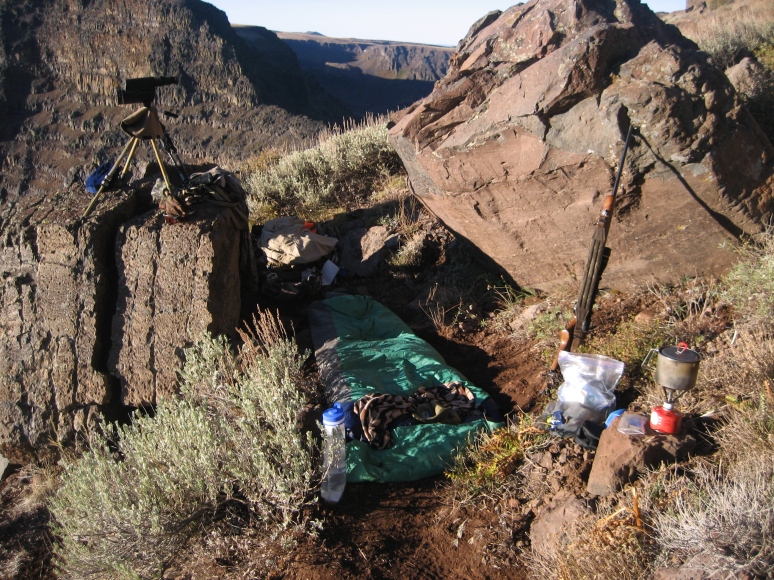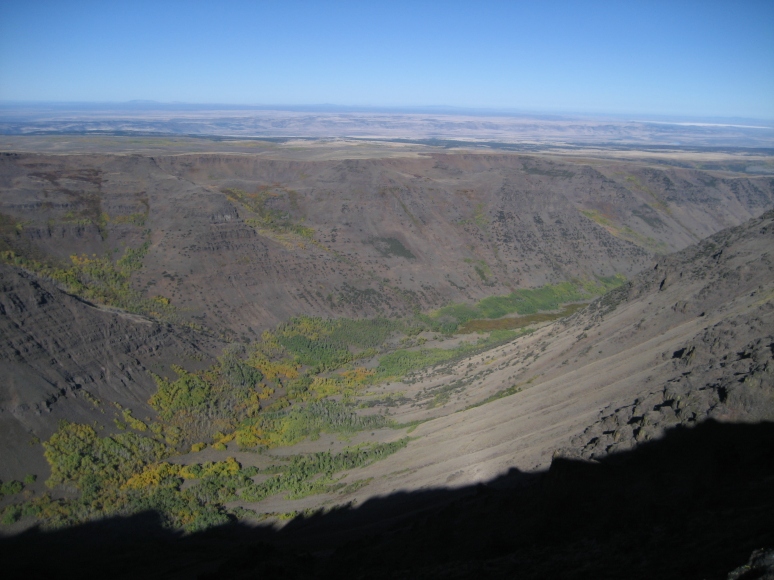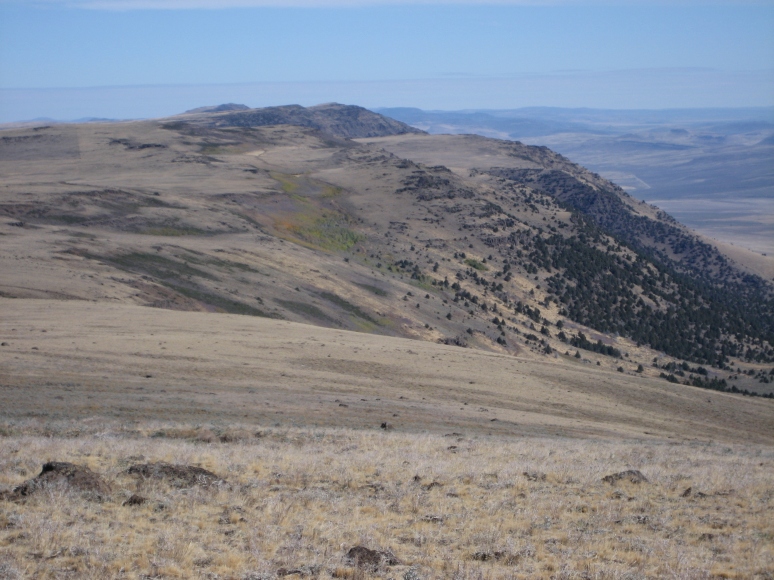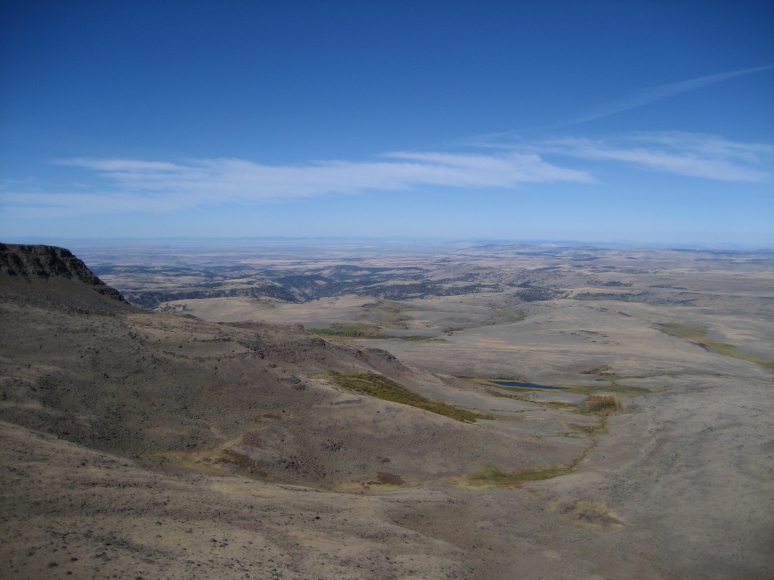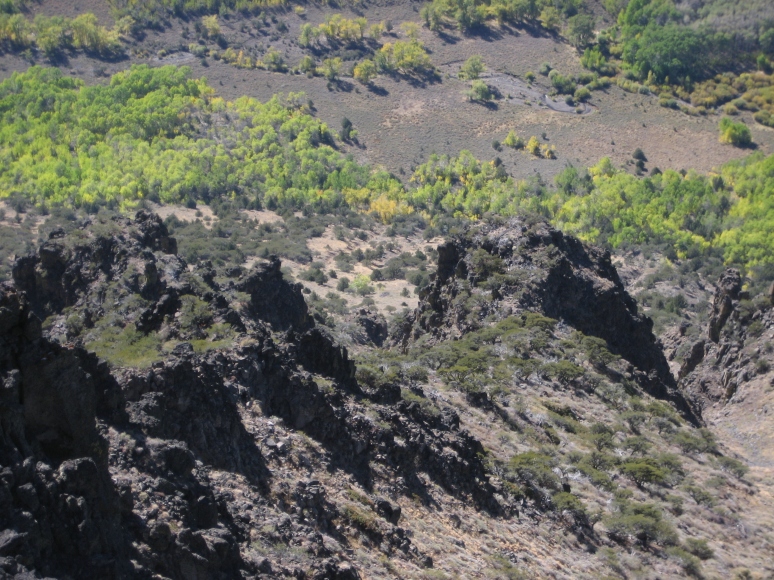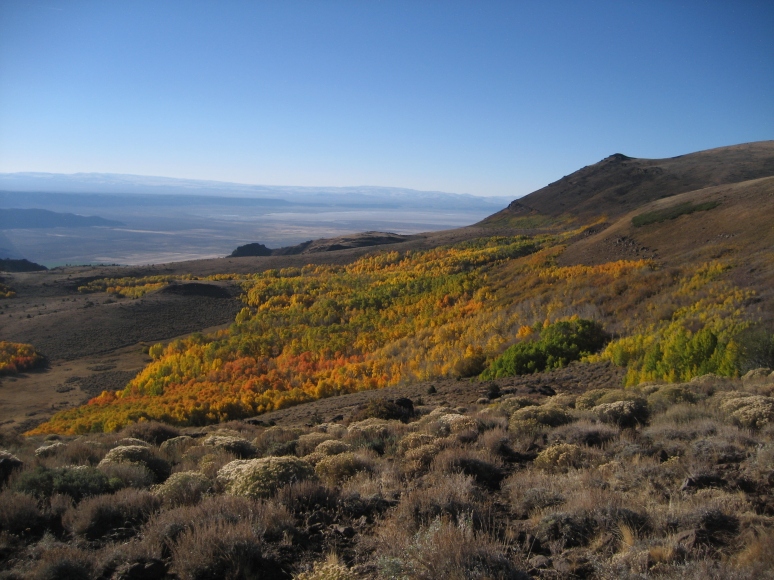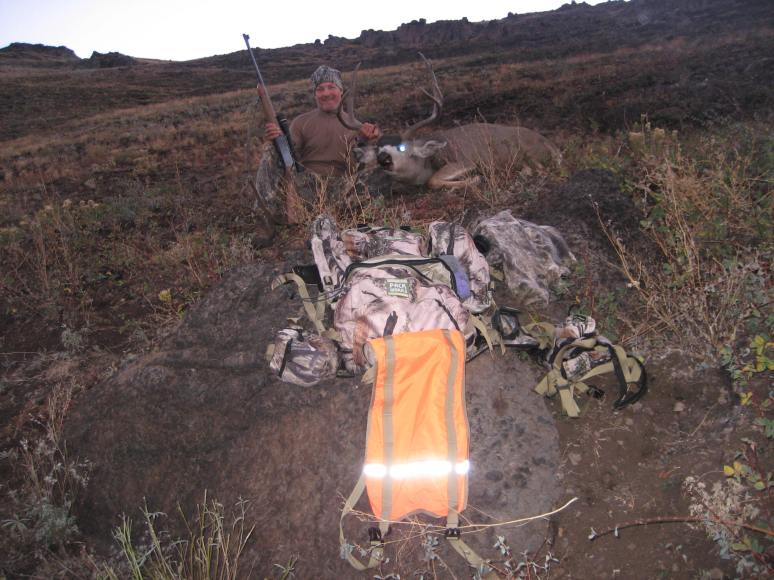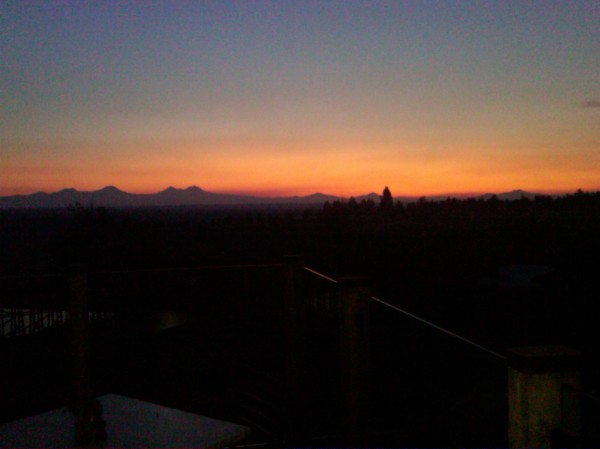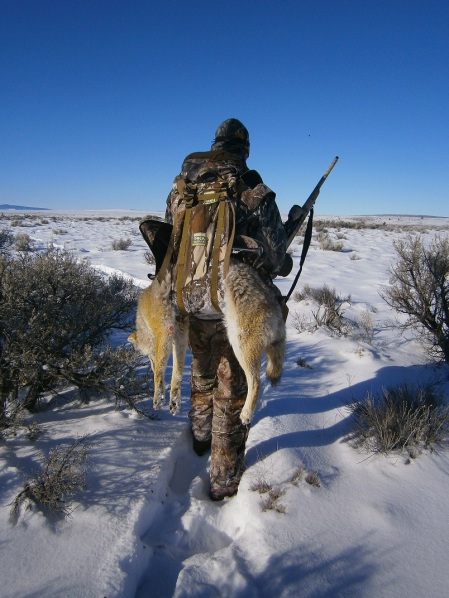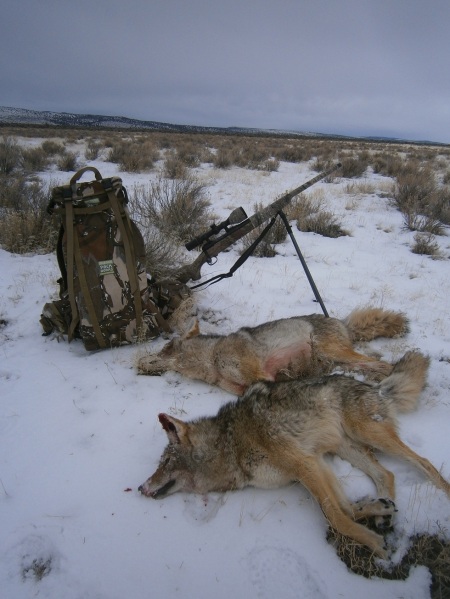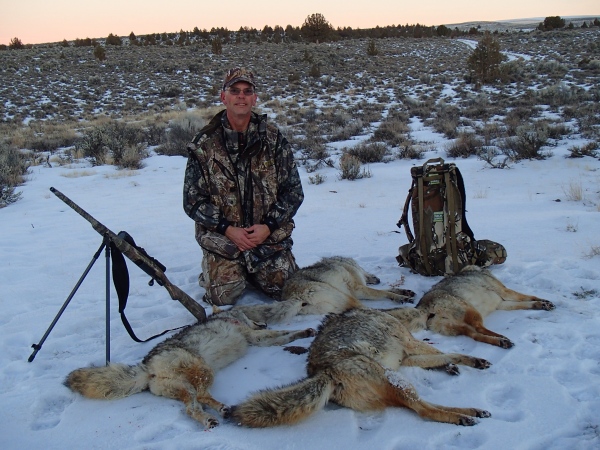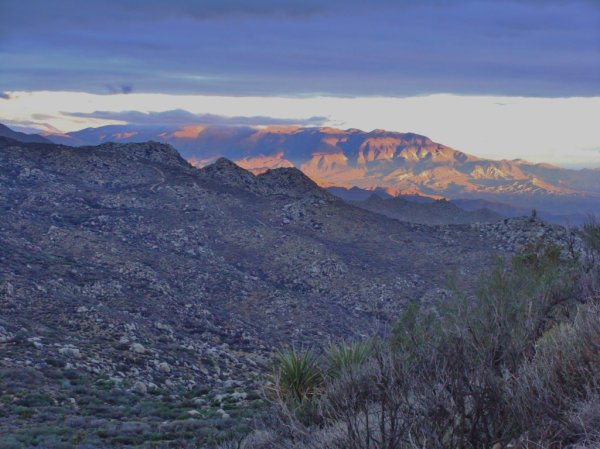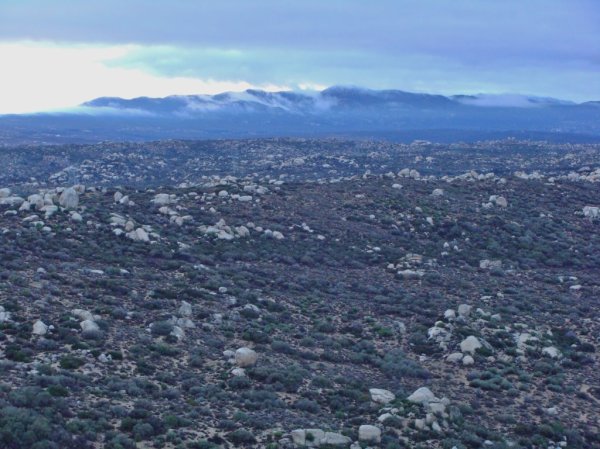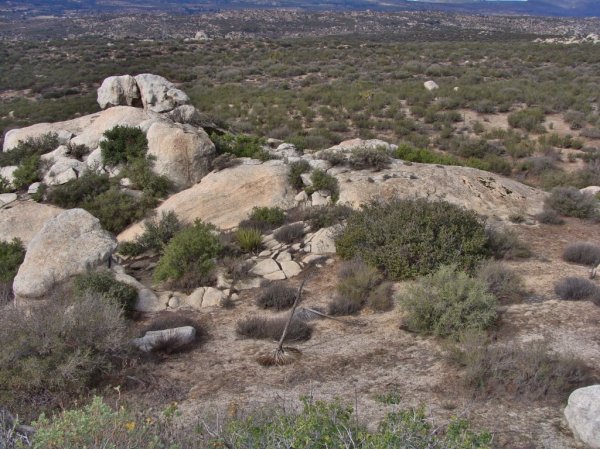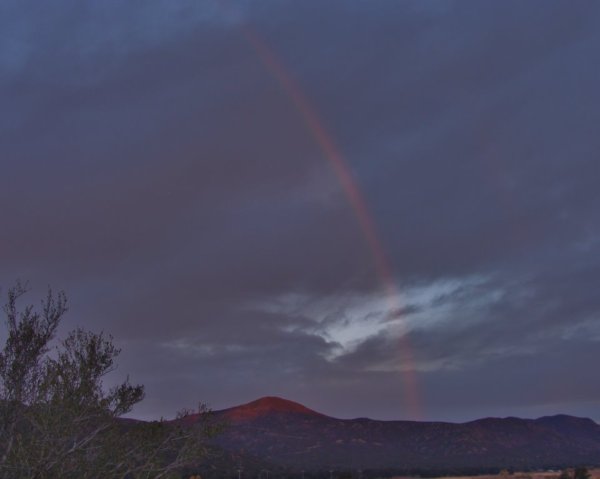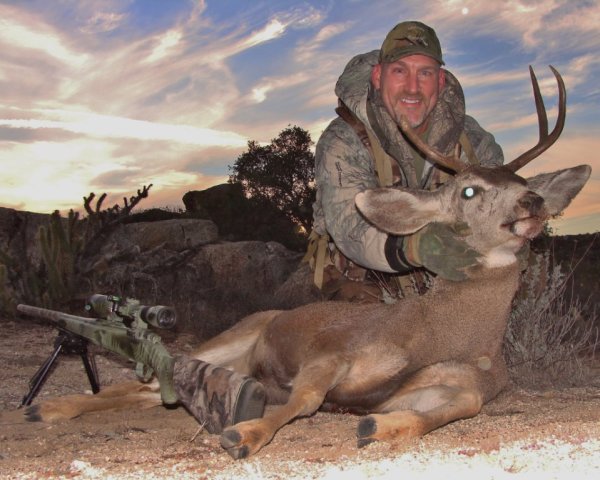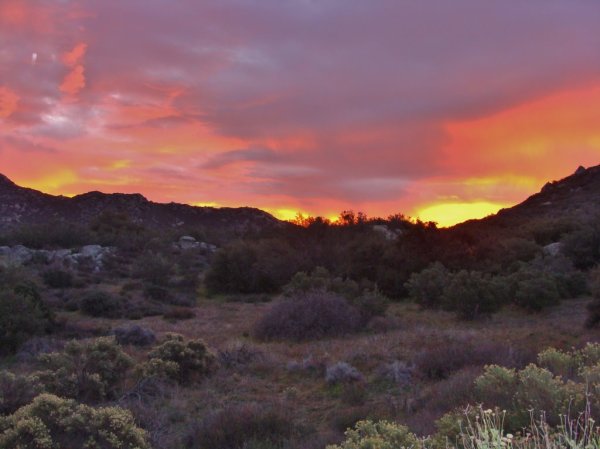2015 Spring Bear: By, Karl J. Findling
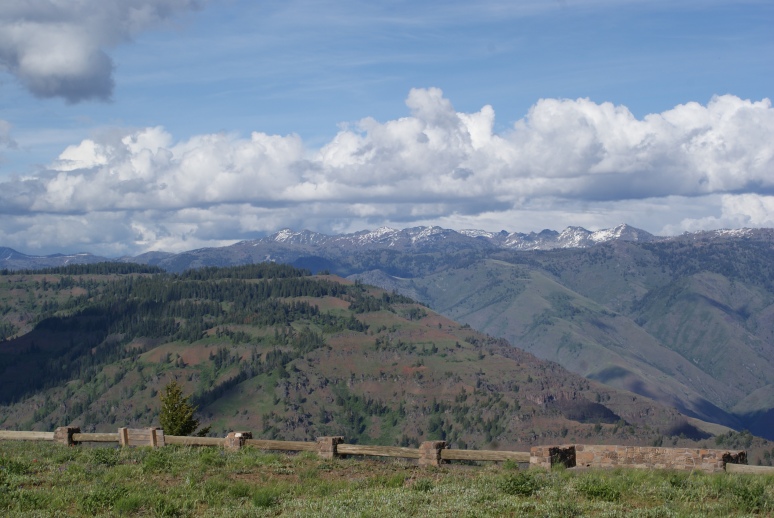
Hells Canyon Overlook
My first bear interaction was in the fall of 1980 while grouse hunting in the Lookout Mtn. Unit of Oregon, close to my home town. We hadn’t thought much about bears despite the robust berry crop we were actively hunting as the Blue and Ruffed Grouse were occupying much of our time and talents.
Now, in 2015 I was on my first Spring Bear hunt with my Brother-in-Law Bob, who had drawn the tag and I hadn’t but had the time set aside to help and to enjoy the beauty of Hells Canyon in the spring. I don’t really know why I’ve never applied for spring bear until now, but I sure regret not doing so before now!
Evening One
The ride to the top was incredible as we decided to camp low, and hunt high–as most glass from a high vantage point. A cinnamon bear dashed in front of the UTV just as we entered the Unit–we took that as a good sign.
The wrap-around weather had been occurring for about a week. It was a rare weather event, and iffy at best as to whether we’d be caught out in a thunderstorm, but we glassed our second bear just before dusk and agreed to return the next morning to attempt to locate him in a large basin.
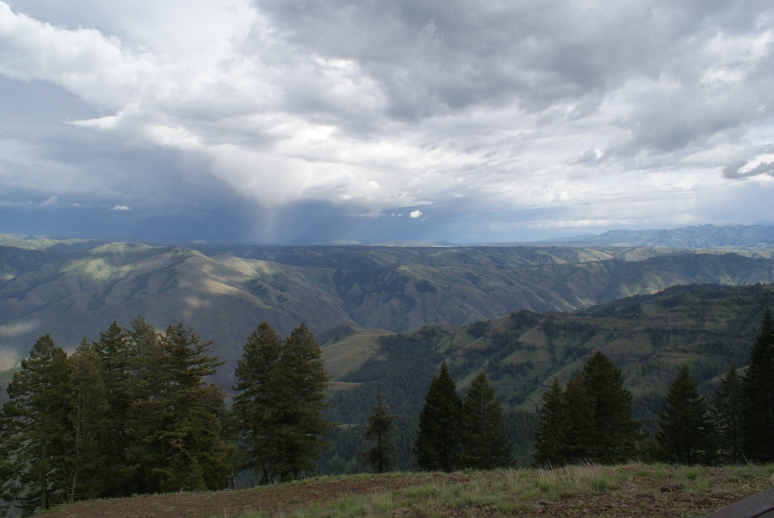
Rain Storm over Idaho
Certainly with all the rain, the array of wildflowers was over the top, and of course a late showing of Morels was much appreciated.
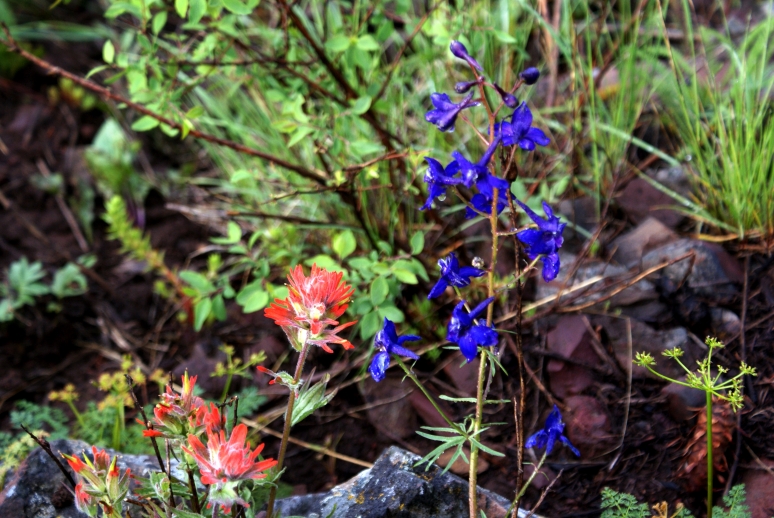
Wildflowers
This year we were told the bears would be out of den early, as it was a mild winter and little precipitation had fallen until the five days prior to our hunt. With the increase in rains and the calving activity ramping up, we felt our timing was good.
I had picked the time for various reasons and we only had four days to accomplish the deed. It had rained for the sixth straight day by the time we arrived at our glassing spot and felt with the forecast we may have a good window to glass and to find our bear.
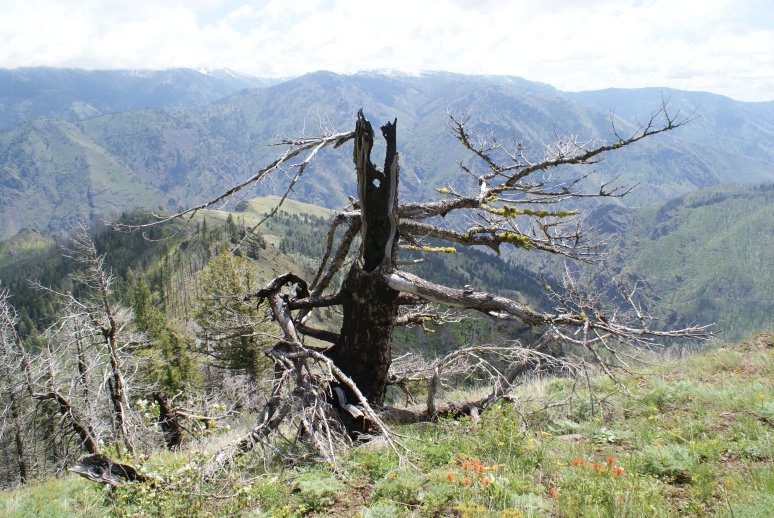
Old Lightning strike snag
We chose an old burn for our glassing as it offered the best of habitat and glassing the more open hill sides.
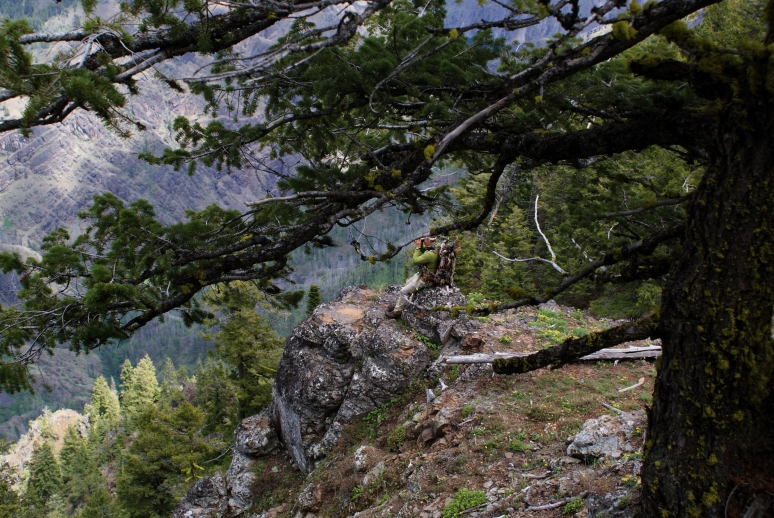
Looking for bears
Morning One, Day Two
The alarm woke us at 0330–earlier then ever for any hunt, as I normally camp within a fifteen minute hike of the animals I hunt. Blurry eyed but excited for the day of glassing we plunged into the darkness in the UTV with all three new high-tech LED light bars changing our circadian rhythm in the hour run to the top.
Bob and I were geared-up wearing Oregon Pack Works’ Orion packs. Mine sporting a .243 Winchester in our gun scabbard buckled-in tight on the outside for a possible opportunity on a cougar, and my Leupold Spotting Scope in between the Overflows. Bob was carrying the Husquavarna in .243 that he’d been carrying since a boy and his first deer. My 2014 Antelope was taken with the gun. Renee’ and I offered the second and third set of eyes sporting binoculars secured in BinoBro’s to shed any weather that came our way.
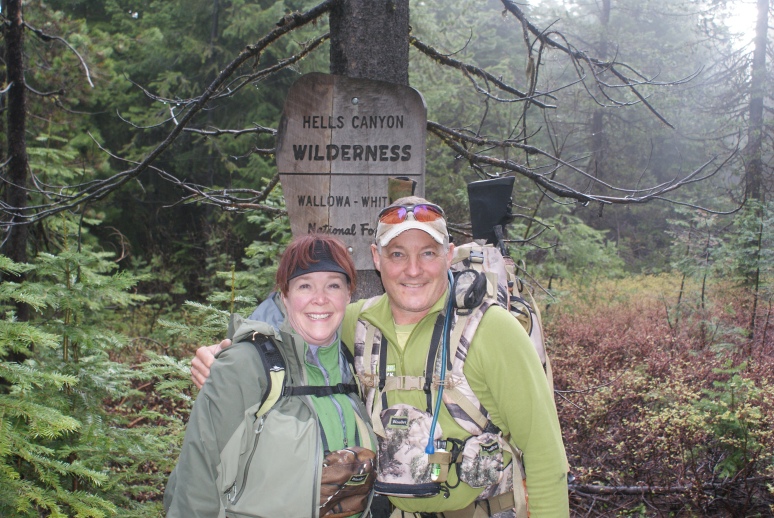
BinoBro bear hunt
We hit the ground running by daylight as we spotted a bear almost immediately upon hitting our vantage point.
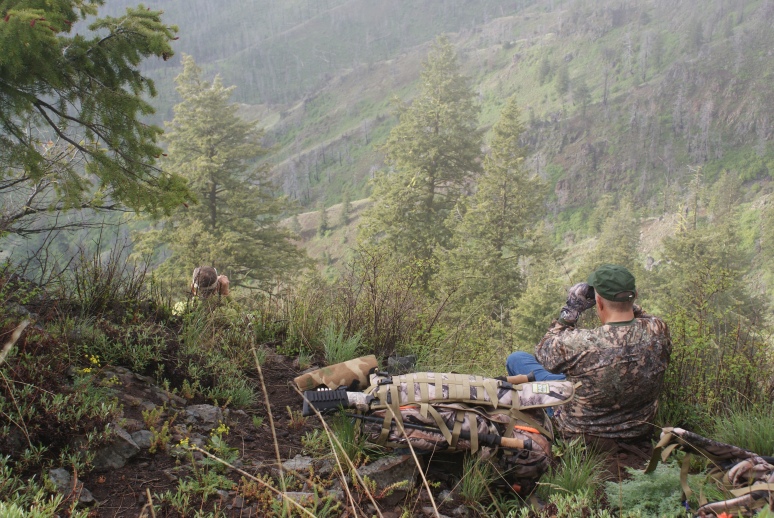
Glassing and more glassing
We made our move down and around a ridge to hide our movements and found a secondary ridge to keep our scent secure and to eventually hide our descent to shooting range.
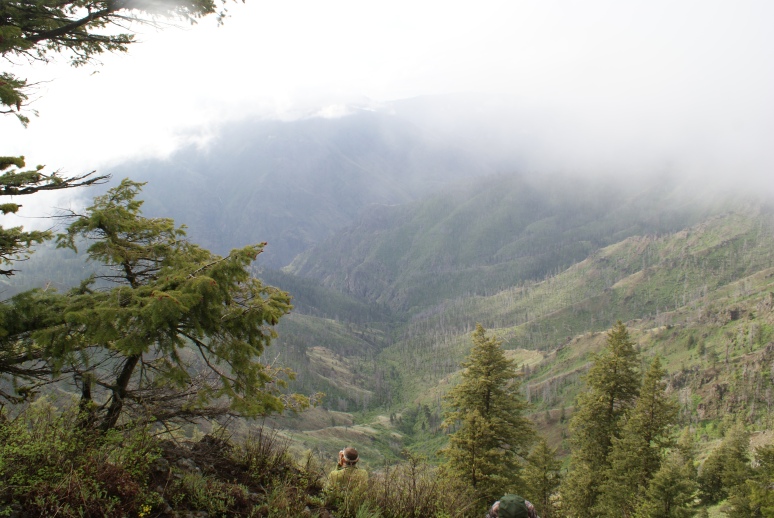
Glassing and more glassing
We were well positioned to make a move when the humidity and the suns warmth conspired against us and created the well known Hells Canyon ground fog–and it silently rolled in.
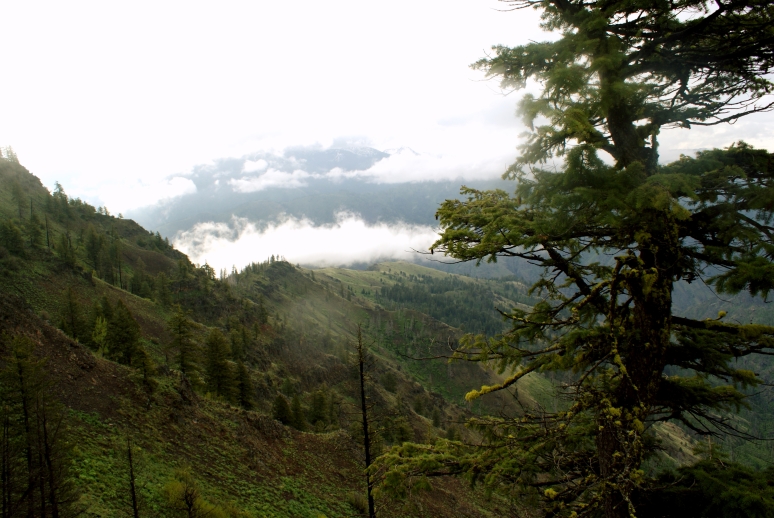
Racing Ground Fog
The cries of a mother elk and the fog had hidden the bears moves and the bear had taken an elk calf right under our noses without us seeing a thing. He quickly moved to the brush to fill his belly and to nap in the now brilliant suns warmth. Momma elk was left barking and looking for her baby calf for the remainder of the day.
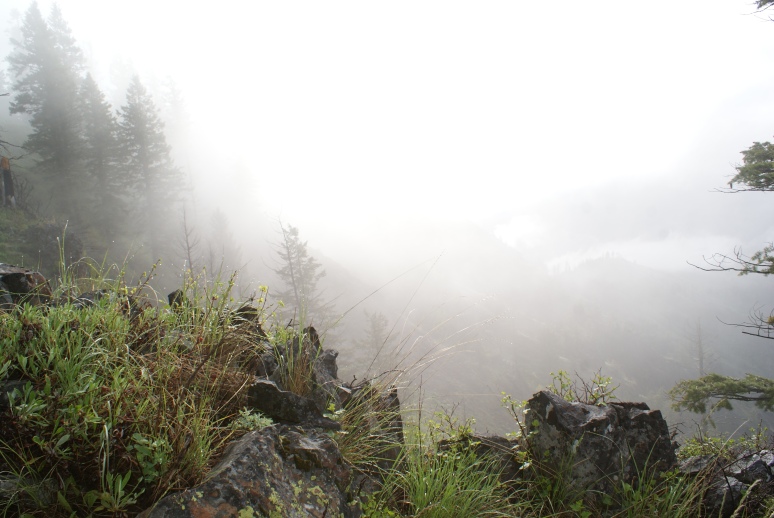
Ground Fog
We hunted through the suns appearance to where we were shedding clothes and putting on sunscreen. We glassed until dusk spotting a very large black about a two hour hike away. The approach would be too much before dusk–we elected to return again in the morning.
Morning Two, Day Three
At daybreak we were back in the same basin where we left Momma elk looking for her calf. We spotted her immediately where she’d been the last twenty-four hours and began our glassing plan from her location.
We glassed for hours in brilliant sunshine and by 1:30 felt our time had run out. We moved to an area with a shaded flat and had lunch and a dirt-nap. By 3:00 we moved to the top of a shaded north face and glassed a very rugged canyon that had burned numerous times. We stationed ourselves there until the evening glassing commenced.
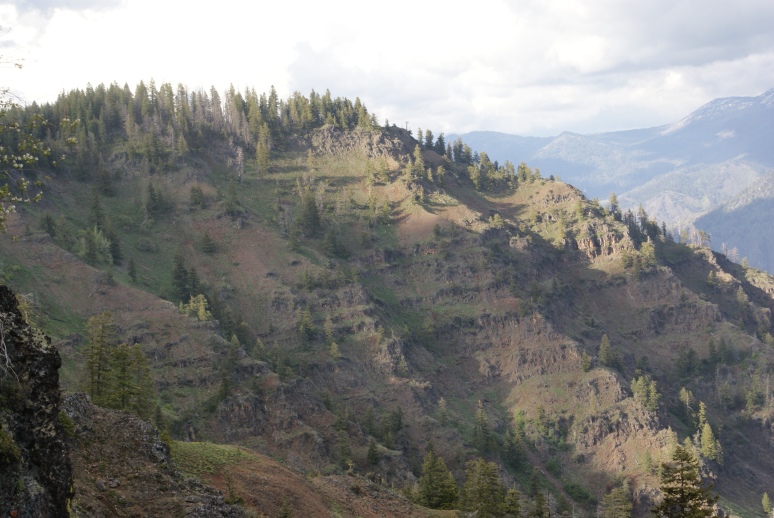
Rugged Hells Canyon, Oregon
We felt that we had picked a basin that was nearly inaccessible and difficult to make a move down in a timely manner. We made an different kind of evening hunt across the tops through numerous meadows and creeks with good habitat. We moved through some great country with strong sunlight hitting in patches and the hunt for morels then preoccupied our time up until dark.
The walk to the rigs that evening produced one of the most surreal sunsets I’ve ever seen, as the sun slid behind the great Wallowa mountains and turned an eerily-amazing red.
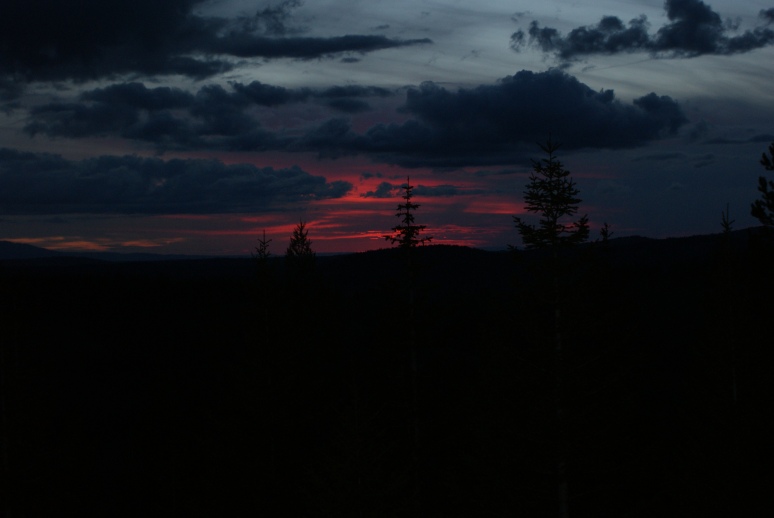
Surreal Sunset over the Wallowa Mountains
Morning Three, Day Four
Late dinners and quick-early breakfasts have been the theme all week, and our last morning was no different. Only Bob and I headed for the top for our last morning as the ladies wanted to catch-up on sleep, talk and get us ready to hit the road at a decent hour.
Just after Bob spotted a blonde object and decided it was a bear and not a broken tree, I put the spotter on it and it was indeed a blonde bear. We watched its movements and decided to make a push. Down the knife edge ridge we moved at a good rate until we were within shooting range. We then proceeded upwind and up-grade into the basin where we last suspected it and, nothing.
We climbed back out and up for a thousand feet and called it a day; and a hunt.
The take home lessons we discussed were: 1). Ticks are very prevalent this time of year–take it seriously! Take the time to tick-check everyone. Lyme disease is a debilitating disease and catching it early (or not catching the disease at all) is key! * Footnote: My Brother-in-Law Bob, was treated for Lyme symptoms after this hunt. 2). Do your research on bear habitat and be patient. If there are no bears–move! 3). Get in shape. The quicker you can move vertically in rugged country the better chance you’ll have of getting close enough for a shot. And, 4). Have fun. Hunt for wild flowers, mushrooms, shed antlers and of course bears.
For more Blog Post stories see: https://oregonpackworks.com/blogs/news/34006465-2015-spring-bear-by-karl-findling
Max’s Meanderings: 2015 A Different Spring Bounty, By: Prostaffer, Max Zeller
The 2015 spring bear and turkey seasons are behind us now, and the theme of this year’s hunts was another very early spring, and the number of folks in the bear and turkey woods.
For the first time in 16 years I failed to harvest a spring bear, nor was I able to pick up a left-over spring bear tag, as none were available—another first. I did manage to draw my first choice bear tag, and I did hunt harder and cover more area this year than I ever had before.
My efforts were rewarded with only 13 bear sightings (less than half the number I usually observe), eight of which I placed my crosshairs upon at less than 80 yards (three were under 10 yards).
However this spring, I had my mind and heart set on a larger, mature boar, and I stuck to my goal.
All the bears in my scope were either sows or 2-3 year old sub-adults. I only saw one bear during the entire month of April, as I was sharing the bears woods with a large number of the newest demographic—shed hunters.
They, and other commercial users, were swarming my favorite areas every day; areas that I have never seen another human soul in all my previous years of spring bear hunting. I tried to change tactics and areas, but I constantly ran into other folks. I talked with other bear hunters that expressed the same observations. The larger boars that I managed to track on a daily basis were dug into deep draws and largely nocturnal. I did managed to put a long stalk on a medium bear in the last hour of the last day, narrowing the distance from 450+ yards down to seven yards, but I let him walk as well. It was a great way to end the season.
Turkey season was a little more fruitful, but again, a very early, warm spring had the migratory thunder chickens that we hunt in eastern Oregon already pushing through our areas before the opener; and the number of folks that we encountered were many-fold compared to previous years.
Most years, we would hunt the snow line, which was sometimes so heavy it limited vehicle access into the higher elevations, but conversely, also pushed the birds down to the lower reaches that we could access on foot.
This year there was absolutely no snow, even at the highest elevations and vehicle access was unabated. People were able to access any and all areas and the birds were spread throughout their entire range. This just meant that our group of five this year had to work harder and cover more areas to encounter enough birds to offer everyone a chance. We spent four long days in the mountains and covered many miles.
There were some close calls that didn’t pan out, and a few missed shots; but in the end we managed to harvest eight birds, a lot of good-natured ribbing, hand shakes and back slapping, and another load of great memories.
DIY Elk Hunting Tips, Part, 2: By Sean Clarkson

Reprinted with permission from Backcountry Journal
Nearly every hunter obsesses about gear, and to some degree gear does make a difference. I’m going to go through what I learned elk hunting on my own as far as the gear that makes the difference and in order of priority. That said, none of this gear matters nearly as much if you don’t get your most important gear (your body and your mind) in shape first through the workouts and homework discussed in the first segment.
Boots:
Elk hunting is done on your feet. As such, your boots are your most important piece of equipment. Boots that work for elk hunting are not at all like boots made for sitting in a treestand or a duck blind, or even going after upland birds. You need good, strong boots with solid ankle support and a rigid sole. Heavy hiking boots work incredibly well, and I went with a pair from Asolo that are leather uppers, Gore-Tex lined, lightly insulated, and have a rigid sole with good ankle support. These boots are flexible enough to be comfortable for long miles and hours of hiking over rugged, broken terrain but are stiff and strong enough to provide support when carrying heavy loads and when maneuvering over rocks, fallen trees, and other obstacles. Other solid hiking boot manufacturers offer similar boots. Make sure that they are very comfortable on your feet while providing a lot of support and that you wear them long enough and often enough before the trip to break them in.

Backpack:
After your boots, I believe the next most important piece of equipment you can have is a well-designed, well-made pack. That pack should have either an internal or external frame (there are adherents to both designs), and it should be able to carry 70 pounds or more. It must fit you well and it must be properly adjusted. A poorly fitted, poorly adjusted pack is worse than useless; it is a trip killer and you will suffer miserably under it. Think about the fact that you will spend at least half of all waking hours of your trip under that pack, and if you are successful then that pack will be what you must use in order to bring that elk out. It has to fit you properly and it has to be well made.
On my first hunt, I used an ALICE pack that I had for many years. While it worked, it was a very bad idea. Even properly adjusted to fit me, the ALICE is just not a good pack for elk hunting and my shoulders, back, and hips ached for days after I got back home – not to mention the agony I was in for the trip. The ALICE, while it was a great battle pack in the 1960s and 70s and has the right volume and load bearing capacity for this kind of hunting, does not provide the necessary support nor the weight distribution to and through the hips, back, and shoulders to afford any degree of comfort with heavy loads, long miles, and rugged terrain. There are, fortunately, far better options available today.
I retired ALICE and upgraded to an Oregon Pack Works “Orion” pack system. To me, the Orion is the most comfortable, flexible pack system I’ve ever owned or used. There are many other good manufacturers out there that make packs specifically for this type of hunting (KUIU, Mystery Ranch, Eberlestock, Paradox, and others). All of these packs combine the volume and load bearing potential you need with the design-built weight distribution and comfort that you will want. They are not cheap, but the price paid is well worth the return in the mountains and for many years to come as they are all built for long service. Finding the one that is right for you, getting it, and getting used to it long before the hunt will pay dividends throughout your time in the field.
The altitude and physical exertion of elk hunting will drain you of your fluids. Proper hydration is essential, and whatever pack you chose ought to have a hydration-compatible system built into it. Dehydration can and will sneak up on you because the dry air wicks away your perspiration rapidly. Having that hydration valve right at your shoulder will help you combat this and stay in hunting form for much longer.
With the pack, game bags are essential. If you take an elk, it will come out of the field (more likely, off the mountain) in boned out pieces. Good game bags protect the meat, allow it to cool, and make clean up of your pack and gear easier once you get home. Take your time to watch videos about how to bone out meat (if you don’t already know), and how to pack these game bags. Doing so before you get to a very large downed elk will help you get that elk processed and off the mountain more quickly.

Tent:
I debated whether to move the sleeping and shelter system to the second, or even the first, slot priority for gear, but it never slipped below third. You will spend roughly 30 percent of your trip sleeping. You will need this sleep because you will be physically exhausted and this sleep will need to be good in order for you recharge, to continue the hunt, and to perform to the peak of your abilities. If the weather turns severe, you may spend even more time in your shelter riding out the storm and waiting for the weather to break. Your shelter should be up to the task, if needed, and it should certainly be amenable to the hours that you will spend in it while asleep.
During my first trip, we used a wall tent with a stove as a base camp and a small backpack tent as a spike camp option. The former are wonderful, with a warm stove and room to stand up, but they are also huge and heavy. The latter was merely adequate, providing simple shelter but little more. I have learned that it does not have to be this way.
The ability to have a warm, heated shelter is truly a hunt-changer. When you are cold, tired, and beaten both physically and mentally after long hours and miles in the mountains, there are very few things more comforting than a warm tent and a good meal. Coming back to a cold, cramped tent and huddling over a pack stove is no way to relax from a hard day and prepare for the next. Several companies make tipi and tarp style tents that permit the use of a wood-burning stove. These tents are incredibly lightweight, yet set up to provide ample floor space and head room to allow you to sleep comfortably near a warm stove and stand up to dress inside that same warm tent in the morning. The tents by SeekOutside, Kifaru, Titanium Goat, and others, weigh in at less than 5 pounds (some considerably less than this) while providing ample space for 2-4 people and their gear. Stoves by those same manufacturers as well as Hill People Gear add only another 2 or 3 pounds to the weight but pay that back with much appreciated warmth. I will guarantee you that one of those tent systems and a stove will be in my pack before I go back after elk, and it will likely become a permanent fixture in my pack regardless of where or what I hunt.
Sleeping Pad
Even with the best tent, if you can’t lie down comfortably then you can’t sleep. I rank a good sleeping pad next on my list. The days of having to suffer a hard closed-cell foam pad or a self-inflating pad that either leaks or doesn’t provide much cushion at all are over. For a backcountry hunter that isn’t counting grams, the ThermaRest NeoAir and the Big Agnes AirCore pads are just about the end of the discussion. Either of these pads will provide you with a comfortable place to rest and a needed bit of insulation from rather chilly ground. As for those hunters who are gram counters, I would assume that they are either far tougher than I am or want to be, or have enough experience to know what lightweight pads meet their requirements. For me, the few extra ounces in weight for either of these pads is worth the trade-off on a long hunt.
Sleeping Bag
A proper sleeping bag is as much a personal decision as can be made for gear, and I won’t even begin to get into how to determine which bag is best for you. Mummy bags, semi-mummy bags, semi-rectangular bags, rectangular bags; down or synthetic fill; any of those will work and all have advantages and disadvantages. The point is that you need one, it needs to fit and work for you, it needs to be warm enough to keep you comfortable to the lowest ranges of your sleep tolerance (some people are warmer sleepers than others) when the ambient air temperature can dip to 0 degrees Fahrenheit, and it needs to be packable. Those are the basics, but you need to find the one that works best for you – and that hunt can be as challenging as the one you are contemplating for elk.
Want more on outdoor and hunting skills like this? Join Backcountry Hunters & Anglers!
Photos courtesy of Philip Peterson, Joseph Castinado and Zach Mansfield
2014 in review
The WordPress.com stats helper monkeys prepared a 2014 annual report for this blog.
Here’s an excerpt:
A New York City subway train holds 1,200 people. This blog was viewed about 4,500 times in 2014. If it were a NYC subway train, it would take about 4 trips to carry that many people.
Max’s Meanderings: California, Bobs and Bucks: By, Max Zeller, Prostaffer
I always try to find new backcountry hidey-holes when I travel the length of California en route annually to visit my brother’s family, and of course hunt, in the southernmost part of the state. I end up taking some breathtaking landscape pix, even though my photography skills leave a lot to be desired and do not do the real life scenery justice.
This year, the late-ending Oregon blacktail deer rifle season left little time for me to travel and hunt So Cal whose southern-most deer rifle season ended a little sooner on the calendar than normal, but I made it down with a week to spare.
This also left little time to do some serious bobcat hunting, but I made a go of it in the hills of central CA, and took a nice tom—called in and taken at 10 yards.
I made it to So Cal on a weekend and decided to hunt right away, due to lack of time and knowing it was hard to find deer let alone harvest one. The weekend hunt idea was a mistake. Even though I pride myself in leaving vehicles behind and packing into the backcountry as far as I can on foot, it is still hard to get away from folks who will drive a 4-wheeler, motorcycle or “jacked-up” truck on any trail they can maneuver; and people flock to the desert and high country on the weekends. However, once the weekdays arrived I was the only human, in most cases , for miles around; and this is when I start seeing deer movement. It takes a lot of glassing (I spend 10-11 hours a day behind binoculars and a spotting scope on a high vantage point) from dawn to dusk just to spot a couple deer in some pretty rough and fractured terrain. Once a deer is spotted I wait till it beds down, then plan my stalk which can be up to a mile or more. The first buck I spotted was a mile and a half away, but appeared to be too small for such a long and arduous endeavor. The next buck appeared an hour later at 800 yards and was also a small forked horn—-tall and narrow with small crab-claw forks. He bedded, but I passed on him as well.
As the morning sun rises higher into the sky and heats the already baked earth, hidden bedded bucks will rise to shift positions, stretch and browse a few minutes before bedding again in the shade for a couple more hours. For a lone buck, this dance continues throughout the day. A half hour after the crab-claw buck settled in for the morning, I observed a very large forked horn buck rise out of his bed 500 yards from my nest on the opposite side of the canyon (for some weird reason I only see forked horn bucks in this remote canyon—even the old white-faced and scarred warrior I took last year was a forky but a mature 4.5 years old). Once he rose, stretched, ate a little, and then moved several yards to re-bed in a shady spot, I planned my stalk which would get me to within 100 yards—the only position for a visual and a possible shot. For, you see, he was bedded on the far side of a short, but steep, brush-and-boulder choked draw. A huge boulder was situated 100 yards up the draw from his new position, and this bus-sized chunk of granite was the only obstacle I could use for the visual and possible shooting position on the big forky. The buck’s face and antlers were the only parts visible as he chewed his cud and watched his surroundings—a cunning position on his part. Moving very slowly and methodically to deter detection, I also stopped constantly to glass the deer while I was still able to. Dodging cholla cacti and trying not to slip on loose rock, it took me an hour and a half to stalk the 400 yards to the boulder.
As I slowly lost elevation from my perch I lost sight of the buck in the draw. My plan was to make it to the boulder undetected, set up for a shot, and wait out the buck until he stood for his next stretching session. That might take hours, but I would be ready. What I was NOT ready for was the buck had other ideas. I lost sight of the buck halfway through my stalk as my downhill path and tall chaparral vegetation was blocking my view. Little did I know, the buck must not have been satisfied with his new digs and decided to head back up the draw in my direction to bed down elsewhere. Well, my stalk was still flawless and I still went undetected, but that buck, unbeknownst to me, decided to bed down in front of the very boulder I was to sneak behind. When I finally made it to the boulder and attempted to set up a shooting nest, imagine my surprise (and the buck’s as well) as I stepped around the rock and almost stepped directly on the buck. He exploded at my feet and disappeared in two bounds through the thick vegetation. The next glimpse I got of the massive forky was two minutes later, and almost a mile away, heading over the next ridge. A great hunt just as well. I climbed back up the mountain and maintained my vigil for the rest of the day. Just as darkness fell on the canyon, the crab-claw buck at 800 yards rose from the exact same spot he was in all day and began to feed. He raised his head straight into the air and curled his upper lip a few times attempting to get a whiff of estrous does, but I saw no does for bucks to chase the whole week I hunted.
Anyway, I had a feeling the next day was going to be my day (I killed my southern muley on the same day last year).
I was set up on my hillside perch before daylight the next morning. A beautiful sunrise kissed the sky and temps were finally cooling off before another hot Santa Anna system was set to move in later in the week. As darkness gave way, I began glassing the immense canyon awakening before me. I spotted no hint of bedded deer or movement of any kind. Over distant ridges two packs of coyotes had a yodeling contest. Two hours passed and still no deer. I then heard a faint thump, followed by a slow series of several more faint thumps. My first thought was that a rig was travelling in the far-off distance and the bass was turned up on the car stereo. But the sound then seemed to be coming from directly behind me on a small game trail. I slowly turned my head and saw a deer’s head and a set of forked antlers on that head looking straight down on top of my head from ten yards—the sounds I was hearing were his hooves walking on the rocks. The buck snorted and bounded off over the ridge—or so I thought. Apparently, the forky didn’t exactly identify me as a huge threat and, instead of heading over the opposite side of the ridge we were on, decided to travel ON the ridge and then drop into the saddle on my side of the hill to get a better look at me. He was standing broadside only 113 yards away and, not wanting to look a gift buck on the rack, decided to secure some southern California back straps. So I did. Curiosity killed the buck.
After unzipping the buck I split him in half and made two one-plus mile trips back to my rig.
My OPW Orion made of tough military/tactical cordura handled the loads in rugged and prickly terrain with ease and comfort, and I had my second beautiful So Cal buck in as many years. As always, I felt very thankful.
Time for me to settle back into life here at home, take in the sweet smell of western Oregon and get ready for trapping season and maybe find a big cat before year’s end. All my best to you and your families for the holidays.
- November 27, 2014
- Back Country hunting, Binoculars, Bobcat Hunting, California, California mule deer, California Mule Deer hunting, DIY Backcountry Backpacks, Gun Scabbard, meat shelf, Mule Deer Hunting, Oregon Pack Works, Orion Pack, Predator calling, Predator Hunting, Prostaffer, Scouting, Spotting scope
- 2 Comments
My Steens Adventure: By, Karl J. Findling
Oh what a place.
Many of us in Oregon know of the Steens Mountain, not just because it’s America’s tallest-of-it’s-kind fault-scarp mountain. Or, be it for the long ice-age glacier-carved canyons charged with the largest aspen groves in the state.
But no, it’s the famed Mule Deer. The reputation for the biggest bucks in the state has faded some over the last ten years. Somewhat due to the ubiquitous decline of Mule Deer throughout the west.
There are varying reasons why, but like most of us here in Oregon, we know that predation is very real since Oregon’s Measure 18 virtually eliminated hound hunting for Cougars.
Locals have reported that a Government trapper has taken 50-60 cougars off the mountain.
Many states report herds in decline from the highs in the 1970’s, or even the peak of the 1950’s, by as much as 70%. I remember herds taking a hit in the bad winter of ’92-’93, all across the Intermountain west.
While there are many variables regionally to explain the drop in numbers, my take is these three things in Oregon: Predation (this includes poachers), Cars, and loss of habitat.
Cars you say? Only my theory, but in Deschutes County, each day I work, I see on a county-wide 911 dispatch computer system, normally about three deer that need pick-up or dispatched–DAILY. This doesn’t include non-reported car strikes, and any number of other car related injuries and deaths. Unscientific, but that’s over 1,200 deer killed per year just in Deschutes County–and that’s just what I see reported.
Deschutes County may be one of the highest in the state due to our proximity to wintering lands and migration through Central Oregon, but remember, this season is 24/7-365, and we are killing our deer much like predators and poachers, with our cars.
But I’ve digressed…
So, with the excitement of a Steens tag in hand, I had a plan to go remote, and to spend the time necessary to tag a big buck–well as usual, the latter didn’t happen, due to life’s circumstances; so I planned to scout three days ahead of the opener.
Glassing would entail a large scope for out of vehicle/stationary viewing and a smaller more compact spotter for the hike/hunt.
First evening I found a remote basin that I could glass through sunset, two large rims, with creek drainages, and good water below.
The next morning I repeated the night before’s glassing, only to find–nothing! So, it was time to strap on the WholeShabang! and head for the high country.
I took the topo maps and headed for some high remote basins, and to the famed Kiger Gorge where I could see all the basins in the few days worth of travels. I would watch for hunters glassing, and decide on a buck “before” the opening day.
Again, just a “plan” that doesn’t come to fruition, as I only find three bucks–in a not so isolated basin–and they are a long ways away.
I found only one spot to create a camp among the steep rocky ground. It looked as if it had previously been a buck bed, so I kicked-out the remaining rocks and settled in for an evening of glassing.
And boy the views! At 9,000′ it is amazing where you can see–three other states!
And as sunset came and went, no bucks–in fact–no deer!
So, with the new morning sun, more glassing and few deer and few bucks–not good.
It appeared as the morning rolled on, that camp would need to be moved for Friday, and find some new ground, or back to the beginning of the adventure, where my vehicle was parked, and come up with perhaps a whole new plan. It was pick-up camp and move on….
So, my “house on my back” and I moved to three other remote areas and I could only find antelope, yes, antelope–at 9,000′. It was apparent that the deer had moved to better ground and the antelope where enjoying these Indian Summer days. Nights were at 50 degrees at 8,000′-9,000′.
So, with the mild temperatures, the deer had to be mostly nocturnal, and I would now have to switch to looking primarily for the feeding areas, observing the direction and quality of tracks left in the dirt.
I struck-out for new ground….
And more…
And, again…
It seemed I was just way to high. The temperatures told me that’s where I needed to remain, and try to catch the deer returning to high-shaded places to stay cool during the day. The one thing that is certain on Steens Mountain, is the wind.
The days had Northwest winds, and the strong diurnals would make it fairly easy to descend or ascend on animals–if I could just find them!
Finally, Saturday arrived and I hadn’t seen a shooter buck yet. So, off I went with my Orion, a compact spotting scope and BinoBro ProHunter with RangeFinder Bro attached to the harness.
I placed my spare cartridge pouch onto the opposite side of the Bro harness in case I found that I had to ditch my Orion, I’d have a few more rounds available and not back at my pack.
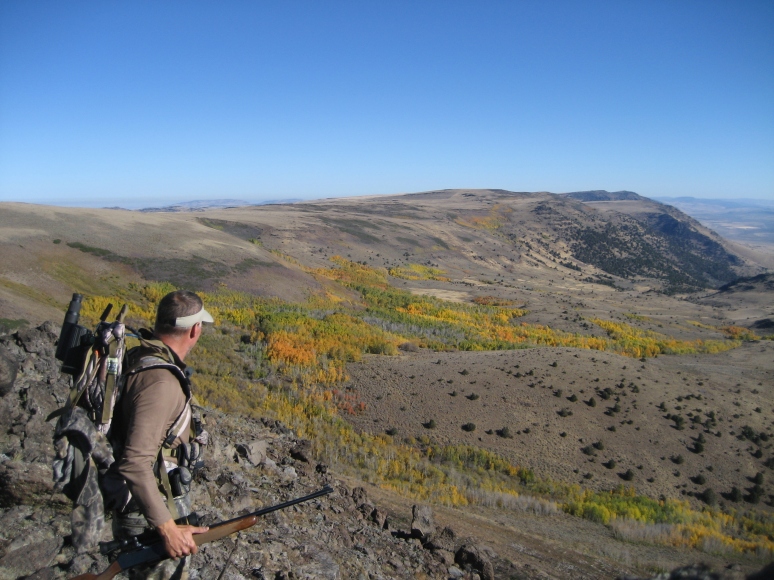
Orion pack; BinoBro ProHunter; RangeFinder Bro; Leupold Gold Ring Spotter; Browning BAR1 in .338 W.M.
The evening winds switched to Southwest breezes warming the evenings and making this more difficult. I secretly prayed for at least cooling, if not rain. Some seasons snow would show-up for opening day and man would that make for awesome deer hunting!
So, by evening of the opening day, I had found deer. It made sense–a year-old burn. So, I watched numerous bucks show-up at the area with the best forage.
I played the wind and watched the activity and bailed out just in time for the diurnal switch of the wind which would give all nine bucks in the vicinity a good reason to leave.
Upon return to my camp–just a miles walk, I encountered a beautiful mountain warrior of a buck that looked to be a big three point, as he rose from the ceanothus velutinus (snow brush) to look over the landscape and depart downhill to feed. A big-bodied buck that I thought I could shoot if it came down to not getting the “big guy.” The Aspen were just on fire, and the landscape just said, “this is deer season!”
Once back to camp two bucks held just 100 yards from me not concerned–one and old non-typical, revert–so over twelve bucks opening day, in the last four hours of daylight; things were improving quickly.
I played the wind again in the morning on my return to the feeding grounds just at shooting light. Again, a good choice as a shooter four point appeared. I set my sights on this buck that was with four other four points, as he clearly was the “big guy!”
These nine bucks ranged from 158 yards to about 250 yards–dead on holds for all, with the .338 Winchester Magnum, BAR 1 that I was carrying.
As bad luck would have it, the shooter disappeared behind a rock pinnacle, and led all the other bucks to their morning bedding area under some mountain mahogany.
I watched them for over an hour and decided they wouldn’t stir to feed until mid-afternoon, and I returned to camp for a nap, more calories and would decide on a game-ending plan for the “big guy.”
It has been said before, “if I didn’t have bad luck I’d have no luck at all…” Upon return the bucks were out of their beds. I looked high, I looked low, I looked left and to the right side of the mountain, and only a couple forked horns and now six does were all up and feeding–3:00 P.M. “Where could they have gone?”
Now with the five four points replaced by six does I hadn’t seen up to this time, I knew something was wrong. Had they ween me depart? Had they winded me?
I had to figure this out, and went off for another look on the north face of the peak…only two small! bucks. What could have happened?
I decided a closer look below the rims that lay over two hundred yards below was the only tactic left–to make something happen. Risky yes, but my only choice.
I descended 100 yards in :45 minutes. Slowly taking two steps and glassing, and not knocking any rocks loose to tumble the remaining 100 yards over the rim to spook those bucks that I knew were below ma away for good.
Well, as I peaked over the rim–nothing! Shocked, I thought, they had to have returned and I just didn’t see them back to the south. So, off I went. And, again, nothing to the south.
My last ditch effort was back to the north face and to peer into the burn. That’s when that old mountain warrior from the night before was below me. He stood as if to say “I’m the biggest-baddest buck here…” He looked full-rut, not pre-rut, and was absolutely beautiful. with just five minutes of shooting light left, I made the decision to shoot. He was just 221 yards, at 32 degrees downhill, and a dead-on hold dropped him where he stood.
I ended his time instantly with a well placed Hornady SST, in 225 grains, from my Belgian-made, Browning, BAR1, and a great reload. I recovered the bullet from under his opposite shoulder and it weighs in at 70% of 225 grains–not bad.
When I approached his enormous body, he had no ground shrinkage. Even though a revert (two years in a row now–maybe three) he was a beautiful buck that fulfilled my Steens mountain adventure perfectly.
Our time away from hunting might involve fishing…
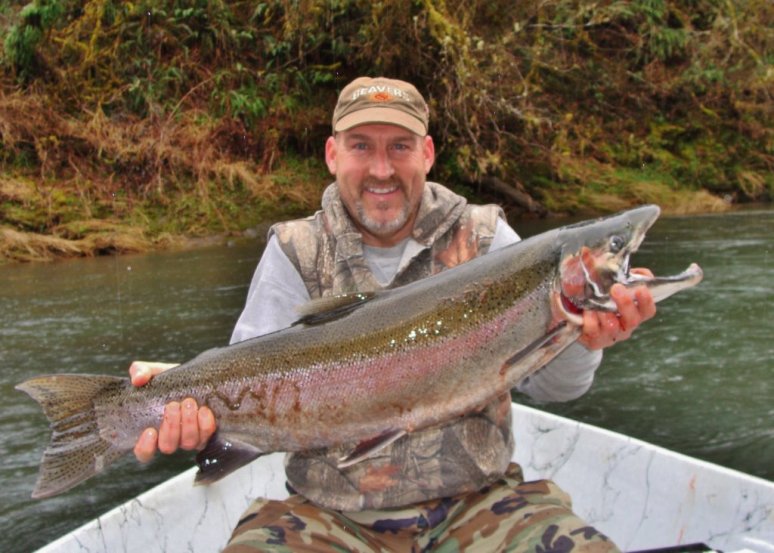 I got all my chores done yesterday so I decided to make a river run from Fall Cr down to my place. Caught 3 beauties, but all native—flipped the hooks out with the pliers in the water and they were on their way unharmed. One big hen, as bright as can be, breached the water five times way up in the air and then stripped line way down river. What a fight—took nearly a half hour to get her in. Thought that couldn’t be beat till I went down today—the same run. Below Stouders I hook into this 15 1/2 pounder and he took me for a ride down river. Finally got him stopped enough to set my anchor, but he went on so many runs when I got him near the boat that I thought my 10 lb leader was not going to hold him. He wrapped himself around my anchor, went into the brush, hit my oars, and knocked my net into the river. I had to pull anchor, hold onto the fish, and row downstream to get my net—all by myself, it was hard to get that big boy. When I finally did get him tuckered out enough to lift his head into the net he barely fit. That fight lasted almost 45 minutes. I had to sit down, catch my breath and wipe the sweat from my brow—that’s a big hatchery fish.
I got all my chores done yesterday so I decided to make a river run from Fall Cr down to my place. Caught 3 beauties, but all native—flipped the hooks out with the pliers in the water and they were on their way unharmed. One big hen, as bright as can be, breached the water five times way up in the air and then stripped line way down river. What a fight—took nearly a half hour to get her in. Thought that couldn’t be beat till I went down today—the same run. Below Stouders I hook into this 15 1/2 pounder and he took me for a ride down river. Finally got him stopped enough to set my anchor, but he went on so many runs when I got him near the boat that I thought my 10 lb leader was not going to hold him. He wrapped himself around my anchor, went into the brush, hit my oars, and knocked my net into the river. I had to pull anchor, hold onto the fish, and row downstream to get my net—all by myself, it was hard to get that big boy. When I finally did get him tuckered out enough to lift his head into the net he barely fit. That fight lasted almost 45 minutes. I had to sit down, catch my breath and wipe the sweat from my brow—that’s a big hatchery fish.
Amos’s Adventures: Coyote calling Tips and Tails….By: Amos Madison, Prostaff
THE “PPP’s” OF SUCCESSFUL COYOTE HUNTING
(Preparation, Perseverance, & Perspiration)
The sun was starting to set behind me and I marveled at the fifty or so head of elk grazing about three quarters of a mile from me, their bodies glistening like beacons in the fading light. I was calling coyotes on what would be my last stand of the day. I had set up on a small ridge in some sagebrush that gave me a good view to my left and out to my front.
The ridge I was on proceeded in an arching curve to my right and ended at a higher point about ½ mile from where I set up. The only thing that bothered me was a tall patch of sagebrush that ran off to my right for about 250 yards, which of course was the direction a very slight breeze was drifting towards. (But no stand is perfect when it comes to calling coyotes.) What had brought me to this spot was I had heard coyotes howling from the distant canyons about an hour earlier and with the elk in the area I felt this would be a productive stand. But I had thought each of the previous 7 stands were equally good in their own way and would have coyotes tripping over themselves to get to me, but to no avail. However I still had high expectations for this stand and would hopefully see at least one coyote before the day ended (hence Perseverance ) . . . . .
Over the last several years I have gotten back into calling coyotes from when I used to do it 30 years ago. Gone though are the days of using mouth calls that would freeze up on you, shooting sticks you held together with rubber bands, clothing that was guaranteed to leave you wet and ammunition that would occasionally go “click” when you pulled the trigger. But even with today’s advancements in equipment used for predator calling, there’s one thing which hasn’t changed: a coyote’s cunning nature. If anything they have become even more challenging to call.
One of the keys to being successful with your coyote calling is just how well you begin your “Preparation”. This would involve knowing the habits of coyotes. Using the right equipment for the task then knowing how to use it, and above all else practice with it A personal friend of mine who is owner of one of the leading electronic predator calls companies on the market told me they frequently have calls and transmitters sent back to them which are believed to be faulty. What they find is that the calls are actually fine; it’s just that the owners didn’t know how to operate them properly. Knowing your equipment and how to use it will certainly tip the odds in your favor of being a successful hunter. Another aspectI stress to hunters is the importance of being familiar with their rifles. It may seem basic, yet I see so many people who never practice. A coyote is not a very big target. Once you get that fur off them their kill zone is about the size of a 6” saucer plate. Add to that the conditions which you may have to be shooting in, such as blowing snow and extreme cold, and it becomes even more difficult to shoot accurately. In addition, rifles being placed in and out of vehicles have been known to have the scopes knocked out of alignment. It’s frustrating if you spend a considerable amount of time trying to call in a coyote only to miss the shot, or several, due to a scope that got bumped. So periodically through the calling season check your scope and practice your marksmanship.
Now all the preparation in the world can be done, but things can and will go awry when it comes to calling coyotes. That’s what makes it challenging—you never know what may happen. I had one stand this season that looked like it would be a good one. The downside was the wind had picked up to about 25 mph with a wet snow blowing in sideways. The temperature was about 20 deg. I knew the wind chill factor was bone chilling. However, I still wanted to try this stand before I called it quits due to the wind. I found a good vantage point on a knoll and put the call out in front of me about 25 yds. I found myself a large clump of sagebrush to sit in. My .223 bolt action rifle was on its bipod and ready for action. I could see for miles from this position. I started my calling and 4 minutes into the sequence I saw a coyote standing about 100 yds in front of me on a small ridge, as usual it had appeared out of nowhere. I eased my rifle up to my shoulder and centered the crosshairs behind its shoulder. Upon squeezing the trigger the rifle went “Click”. The coyote looked in my direction, but was still trying to figure where his meal was. I thought the shell might have been a dud, so I loaded another round while the coyote was moving to a new spot. When he stopped the trigger was again squeezed, but again the rifle went “Click”. The coyote moved, and I again put another round into the chamber. I thought third time had to be a charm, so when the coyote stopped about 60 yds away I squeezed the trigger. . . . . “Click.” I knew then that my rifles firing pin was froze up due to the moisture and extreme cold. That was one lucky coyote that day.
When I leave my truck and walk to a stand I have the following essential equipment with me. My rifle, electronic call, rifles bipod, sitting stool, and of course my Oregon Pack. All this equipment is carried by my Oregon Pack in the Rogue configuration with the meat shelf (aka “coyote carrier”) attached. I have found with the increased popularity of predator calling that call-wise coyotes have become weary of stands within close proximity to traveled roads. This is where the “Perspiration” factor comes in. I will strap my Oregon Pack on and head for distant hills that I know aren’t being called. This means fewer stands are called in a day, but I have found my success rate is higher. The use of my Oregon pack makes this an easy chore. Case in point: this winter I walked to a hill about ¾ mile from the road and set up. The hillside was a steep one, but it afforded me an excellent view off towards the sagebrush flats out in front of me. About 8 minutes into the call I heard a slight sound back behind me up in the rim and noticed a raven flare up into the air. About 45 seconds later a coyote suddenly appeared from off the hillside to my right and was almost on top of the call. I managed to make the shot just as the coyote decided he needed to be somewhere else. I continued my calling sequence and about 6 minutes later a coyote came trotting across the flats in front of me. When he stopped less than 50 yds from me I made that shot. If it weren’t for my Oregon Pack I would have struggled carrying two coyotes back to the truck over ¾ mile distance. But in this case I simply loaded the coyotes onto the pack and strapped them down with the meat shelf. The walk back to the truck was a simple task.
The last thing I have found with calling coyotes is to be “Perseverant”. I’ve called on days that I thought would be good due to weather conditions, but turned out I wouldn’t get a single response. Yet at other times things fell into place just when it seemed like nothing was working, which brings me back to the opening of this article. After having called 7 stands previously without seeing a single coyote I was determined to give it one more try. The elk were off in the distant grazing and my call was out in front of me about 25 yds, when I started my calling sequence. I had been calling for 13 minutes and was already thinking about shutting things down when I saw a coyote walking through the sagebrush on the hillside to my right. I estimated it was about 500 yds away. As I watched it sat down looking in my direction. It seemed disinterested in what I was offering for a meal, but after sitting there for several minutes it started trotting down off the hill headed right for that large patch of sagebrush on my downwind side. My rifle was up and at the first opportunity that I could get my crosshairs on its shoulder I planned to fire. If it got my scent before I could fire, I knew I wouldn’t have another chance. As the coyote was slipping through the sagebrush I got it to stop in an opening at about 175 yards and was able to make the shot. As my rifles shot was echoing off the hills I looked back up where this coyote had originally appeared and there were two more coyotes. But with the rifles shot they had started to run up the hill away from me. I got my call back into action and the coyotes stopped. One of them was hesitant to make any move, but the other one started down the hill towards the same patch of sagebrush the first coyote had went into. However I noticed it was going to stay out further and try to pick up my wind. When the coyote entered into the sagebrush I lost sight of it, but within a couple seconds it was running out of the sagebrush and back up the hill from where it came. I managed to get it to pause just for a second and was able to drop it at a distance of 276 yds. I immediately checked off to my left and there was another coyote that had been working its way in, but at the shot it too turned and started running back out. With some quick coaxing from my voice I got it to pause at a distance of about 250 yards and dropped it too. By this time 34 minutes had elapsed since I started the call. I figured I might give the stand another 10 minutes or so and see if anything else were to happen. With a fresh magazine inserted into my rifle I was ready. Eight minutes later a large coyote suddenly appeared about 200 yards out in front of me and headed right towards my position. When he paused about 80 yards away I dropped him. I now had 4 coyotes scattered about in all directions and was concerned that the waning light was going to make it difficult to locate them. I took my Oregon Pack and placed it on top of the sagebrush I had been sitting in and dropped the fluorescent orange panel down. By using the orange panel as my reference point I was able to quickly locate all four coyotes. What had started out as a slow day ended in a fast and furious finale.
Amos’s Adventure’s: An unseasonable Archery season means a change in tactics.
I was perched 20’ up in a tree when the buck stepped out into an opening 32 yards away broadside, the afternoon sunlight giving his body the appearance of a bronzed sculpture. It wasn’t until he turned and looked my way that I realized his antler spread would be close to 30” wide. This was a buck worth trying for. I drew my Mathews bow and placed my 30 yard pin behind the shoulder, telling myself to concentrate on a smooth release.
I found myself at this moment after having applied for a late season Eastern Oregon archery deer tag last spring. Like so many other people I apply for one of these coveted tags and if not drawn then hunt the general archery bow season. However this year I was fortunate to draw one of these tags and knew then I could concentrate during the general archery season for elk, as I now had a deer tag that would occupy my time in November.
The area I selected to hunt was a vegetation transition area that had timber in the higher elevations with a mosaic of juniper and sagebrush lower down. It was with high anticipation that by the time I started my hunt this second week of November the mule deer bucks would be rutting and moving into the lower country. I knew it really wasn’t going to do any good to pre-scout this late season hunt as the deer usually don’t move into the area until higher elevations get hit with snow. I was just going to hope I had enough days in the hunt that deer will have been forced into the area by the weather. However, as my hunt date approached it was apparent the weather was not going to be cold and snowy as what I hoped for. In fact it was going to be mild temperatures with bright sunny days. None the less I was going to focus hunting from either a ground blind or tree stand regardless of what the weather was. My record for stalking mule deer over the years has not been very productive, so my strategy was going to be, “wait for them to come to me”.
Upon my arrival in the area I glassed a number of deer, which was more than I expected to see. But there didn’t seem to be any rutting activity going on yet. At least there were some deer already in the area and I knew from my experience that when the larger bucks start into the rut they can just appear over night from nowhere, so the fact there were at least some deer in the area was encouraging.
After a day of glassing I noticed several different groups of deer hanging out in one particular area. With one of these groups was a small 2×3 buck. I had also glimpsed a larger buck slipping through the trees, but I wasn’t able to get a good look at him. It was in this area that I would put a tree stand up and hope for the best.

The following morning I worked my way into the area with my tree stand and climbing ladder. After selecting a tree that gave me good visibility in most directions out to 40 yards I began unloading my Oregon Pack Works pack of my safety ropes and climbing harness. With my climbing ladder assembled and secured to my tree of choice I could then begin to safely attach my stand and additional safety ropes. After about an hour the stand was safely in place about 20 feet off the ground. I was ready for the afternoons hunt.
At about 1pm I climbed into my stand and settled in for the wait. The afternoon was gorgeous as the winds were light, and the migrating birds were abundant. From a tree stand you see nature in its most natural state. For the most part, wildlife goes about its business completely unaware of your presence. On this first afternoon I had only been in the stand for about two hours when I saw several does moving through some trees about 200 yards distance. Then the 2×3 buck I had seen a day earlier, showed up behind them. The deer appeared to be working their way towards me as I patiently waited. In the mean time I continued glassing a distant ridge about ¾ mile away when I spotted a nice buck lying in a clump of sagebrush. At that distance it was difficult to tell just how big he was but it looked like he might be around 150-160 P&Y. It suddenly appeared that the area had potential.
About 1 ½ hrs after seeing that 2×3 buck and his does, they suddenly fed out of a group of trees about 75 yards in front of me. I had a front row seat as the sun was starting to set over the horizon. I also knew that I wouldn’t be able to get out of my stand until well after dark since these deer were so close to me. Then for some reason a yearling walked away from the herd and walked right over to my tree. While it was standing at the base of the ladder, I glanced over at that buck and here he came at a trot. He was grunting all the way. That buck ran right up to the base of the tree and I had to look down between my toes to see him. Whatever the buck was saying caused the yearling to turn and run back to the herd. Then the buck trotted back to his herd too. Moments like that are priceless. As the deer moved off I was able to climb down out of my stand and think what a good day it had been.
The next day I climbed up on a high ridge to look across the basins and not a deer could be seen anywhere. I knew that the deer were more active in the afternoon/evening and by early morning were probably off resting up somewhere. So morning hunts were out of the question if I didn’t want to disturb the area with my presence.
So at 2pm I climbed back in to to my stand to begin another afternoon’s hunt. The afternoon was again very quiet with the wind dead calm and birds flying everywhere. I had to remember to watch for deer and be careful about becoming mesmerized by the tranquility of the afternoon otherwise something would walk right up and I wouldn’t be ready. As it was that would have happened if I hadn’t looked behind me for some reason, for there was a deer working its way through the trees my direction. As it came through an opening I could see it was a buck, but I couldn’t tell how big yet, until it stopped 32 yards away as I had described at the start. When the deer first stepped out I could see it was a nice 3×3, but I was still undecided about whether I should shoot. My decision was made for me though when it turned and looked my direction. I estimated the antler spread to be close to 30”. I had my Mathews in hand and when the buck turned to look away from me I drew. I had to close my eyes to settle my nerves knowing that I had limited time for the shot, but I needed to coach myself mentally “Do not rush the shot”. When I opened my eyes my 30 yard pin was right where it needed to be, thus I began to slowly trigger my release. As my arrow left the bow it flew perfectly to the spot behind the shoulder I was looking at. The buck launched forward at full speed and after about 150 yards, collapsed.
The inside spread of this magnificent buck would measure just over 29” wide.
This brought to an end a wonderful experience that will yield another memory for life.
Max’s Meanderings: The Gold (-en Buck ) Under the Rainbow. By Max Zeller, OPW Prostaff
The California Dept of Fish and Wildlife (formerly known as DFG) lists six sub-species of mule deer in the state of California as follows: 1) Columbia Blacktail (Odocoileus hemionus columbianus), 2) Northwest Mule Deer (O. h. hemionus), 3) California Mule Deer (O. h. californicus), 4) Inyo Mule Deer (O. h. inyoensis), 5) Burro Mule Deer (O. h. eremicus), and 6) Southern Mule Deer (O. h. fuliginatus). In Oregon and northeast California, we’re familiar with the large-bodied, heavy-racked Northwest variety. However, I decided to target the smaller racked, blacktail-sized Southern Mule Deer species in the D16 hunt zone of southern California—the most southern hunt zone in the state which is basically bordered by the Pacific Ocean in the west, the Anza-Borrego desert to the east, Baja, Mexico to the south, and Riverside county to the north. My brother lives in the eastern hills of San Diego county where I’ve hunted predators twice a year over the last several years and, at the same time, kept mental notes of the heaviest concentrations of mule deer sightings and sign. The habitat I would be hunting is a mixture of high chaparral brush country at 4,000 feet elevation, bordering the arid desert.
I knew from research and years of scouting, that taking a legal buck in the D16 zone, where 3,000 tags are issued yearly, would be challenging. Mule deer numbers in southern California were very healthy during the 1960s and 1970s (pre-housing/land development/population boom). Deer populations in the 1980s started taking a nose-dive as critical wildlife habitat was losing ground to massive land development as the California real estate market skyrocketed, as well as other detrimental land management practices. In addition, along with untamed suburban sprawl into the backcountry came the necessity for wildfire suppression, resulting in overly-thick stands of mature scrub that further reduced forage quantity and quality over large tracts of critical deer habitat.
In the first few years of the new millennium dismal deer harvest success rates in zone D16 hovered between 4-7 percent. Then came the massive east San Diego county wildfires of 2002-2003, and the infamous 2007 deadly wildfires that burned thousands of acres of back country. The loss of human life and private property was devastatingly sad. The only silver lining was the benefit to wildlife and their habitat, especially deer. The fires opened up thousands of acres of choked-out canopy, and with well timed rains, produced large quantities of quality deer habitat—and deer numbers flourished. So did hunter success rates. By 2010, deer hunter success in zone D16 climbed to nearly 12 percent, and since have hovered around 10 percent. CDFW states that overall deer numbers are stable to slightly declining.
Due to some family obligations I arrived at my bro’s house on the 17th of November, a week later than planned. I was hoping the rut was still near its peak—I knew if I could find does, a buck would not be far behind. I was out in the mountains before daylight the next morning, at a pre-determined hillside overlooking a large, shallow basin of high scrub oak, boulders and cholla cacti. I found this large, shallow, brush-choked draw last February while fox hunting and noticed two bucks travelling together down the draw out of the chaparral towards the desert, their antlers flashing in the sun as they passed through small openings in the scrub. I knew then that I would return and hunt this spot in November, so here I now sat on the western slope of a cone shaped mound waiting for daylight, spotting scope and binos at the ready.
As soon as it was light enough to see, I spotted movement 890+ yards away on the other side of the draw. A big, handsome buck with forks as wide as his ears, and just as tall, was shadowing a doe as she moved and fed. I couldn’t believe my luck at finding a deer already, let alone a legal buck. Scouting really does pay off. I needed to wait for them to bed down before planning a stalk. I glassed the rest of the terrain thoroughly for more deer and found none. Both deer cruised around for about an hour before the doe decided to bed down next to two yucca plants. The buck stood next to her on guard for the next half hour, and with the rising sun now casting light upon his majestic body he sparkled like a diamond in a beautiful high desert setting. The wind was howling and ice cold—I felt like I was back in Montana.
Finally, he bedded down within 10 feet of the doe, and I planned my stalk. I picked my landmarks and knew that I would have to take a shot from an elevated position on my side of the draw. If I passed over to their side of the draw, the tall thick brush would totally block any view of the deer, and trying to weave my way through the noisy scrub would spook the couple long before I could make my way to their position. It took me one and a half hours to cover the 600 yards to the boulder patch I planned on making my stand. The last 200 yards of that stalk was on hands and knees, and I praised my decision to wear my thick wool pants and gloves that morning—“jumping cactus” is hard on human skin. I glassed often to maintain a visual on their position, trying to remain hidden from the ever vigilant buck who was facing me the whole time; and I kept the sun and wind in my favor. Upon arrival, I peeked between the crevices of the boulder patch and finally spotted the buck’s antlers poking over the brush 283 yards away. I couldn’t see the doe , but I knew they were both still bedded and this was as close as I would be able to get for a chance at a shot.
I set up a firm, steady platform for my bipod, dialed in my scope and waited for the deer to stand. The wind seemed to be gusting even harder, funneling left to right down the draw and it had me a bit concerned. Like Montana, if/when the moment of truth arrived, I would wait for a lull in the wind gust to squeeze the trigger. That moment arrived a half hour later. The doe decided to stand and stretch and, of course, the amorous buck followed suit, standing broadside. The crosshairs were solid behind his shoulder and I waited for my lull in the wind. When it came, I squeezed the trigger and instantly heard the ricochet of the bullet off a rock, and not the satisfying “thwack” of a bullet on hide. I re-acquired the sight picture in my scope as I jacked in a new round. The buck was still in the same position, but the doe began to move. Before I could squeeze off another round the buck followed after the doe over the adjacent ridge. A boulder was directly in front of the buck and I knew this was probably the rock I hit, the strong wind on their side of the canyon pushing my bullet clear of the animal.
I packed up my gear and made my way to their bedding site. No blood or hair. I began tracking the couple in the white sand. A half hour later I climbed a house-sized boulder to get a better view. Several hundred yards away I spotted the pair pass through a small opening as if nothing happened—the buck was still shagging the doe with no apparent malady. I was thankful for the clean miss. As the morning progressed, I tried to cut them off once more for another chance, but I got busted by the doe and the hunt was over. During the long hike back to my vehicle, I jumped a small “sporky” right at my feet, but the brush was so thick and high I only caught a fleeting glimpse as he disappeared. Still, I was stoked—two buck sightings the first morning, a great stalk and a clean miss—I was very appreciative.
I made it back to my pickup, had lunch, and then decided to head back to my hillside perch to glass the rest of the afternoon. An hour later I spotted the sporky buck I jumped in the brush earlier. He fed along, then bedded in an opening around 350 yards from my nest. I placed the spotting scope on his position and used my binos to scan the rest of the canyon. Another hour passed when the sporky got up and disappeared in the maze. Soon after, while scanning to my right, I saw a bedded buck’s white face peeking through a mass of scrub oak at over 500 yards. Wow, three bucks in one day in a zone that has a less-than-stellar reputation. As he turned his head I could tell he had a fork on one side and a broken antler on the other. Nonetheless, his facial features gave him the look of an old buck, and when he stood his blocky body convinced me to try to take this deer. Luckily, he fed in my direction and, with the sun going down over the Pacific, it was good timing.
The wind had died down and with a little over an hour of shooting time left, the old warrior worked his way into a huge boulder and brush patch 281 yards directly below me. When he emerged broadside and paused to scan the area, I placed a Barnes TSX bullet right through both shoulders, taking out the top of his heart and both lungs. He lunged 20 yards and landed head-first into a huge cholla cactus.
I couldn’t have been happier if it was a huge four-point—I had now taken a deer in the most northern boundary of Washington State, Oregon and now within sight of the border wall with Mexico. The old buck was truly a warrior. Not only was his right antler broken off just above the fork, but his face had the scars and scabs of many fights past and present—a good deer to take out of the pool.
After dressing the buck, I hiked back to the pickup and called my brother. I thought it would be special to share the pack-out duties with my brother who doesn’t get the chance to do that kind of thing very often (he’s helped me pack out a bear and elk over the years).
He arrived an hour later as I was coming back out with the hind quarters. Together in the dark, he helped me quarter and pack out the rest of the animal and, to me, it was special hiking out of the desert with my brother, under a star-filled sky and a full moon rising.
-
Join 795 other subscribers
Categories
- Antelope
- Antelope hunting
- Back Country hunting
- back packing
- Backcountry Safety
- backpacking
- Bear Hunting
- Bicycle Panniers
- BinoBro
- Binoculars
- Black bear hunting
- Blacktail Deer
- Bobcat Hunting
- California
- California mule deer
- California Mule Deer hunting
- Calling Predators
- Canoe hunting
- Chukar Hunting
- Chukar Partridge
- Coyote hunting
- DIY Antelope hunting
- DIY Backcountry Backpacks
- DIY hunting
- DIY Montana
- eastern oregon
- eastern oregon turkey hunting
- Elk Hunting
- Gun Scabbard
- Hunting from bicycle
- meat shelf
- Montana
- Montana Antelope
- Montana Antelope hunting
- Mountain bike
- Mountain Bike hunting
- Mountain wether forecasting
- Mtn. Bike hunting
- Mule Deer Hunting
- Oregon Pack Works
- Oregon Pack Works Panniers
- Orion Pack
- Predator calling
- Predator Hunting
- Prostaffer
- Scouting
- SiliPint
- Spotting scope
- Steelhead fishing
- Turkey Hunting
- Uncategorized
- Upland Bird Hunting
- Weather
- weather forecasts
How it Works Videos
-
Recent Posts
Archives
- March 2018
- July 2015
- June 2015
- December 2014
- November 2014
- October 2014
- March 2014
- January 2014
- December 2013
- July 2013
- June 2013
- May 2013
- April 2013
- March 2013
- February 2013
- January 2013
- November 2012
- September 2012
- July 2012
- June 2012
- May 2012
- April 2012
- March 2012
- February 2012
- January 2012
- December 2011
- November 2011
- October 2011
- September 2011
- August 2011
- May 2011
- April 2011
- March 2011
- February 2011
- January 2011
- December 2010
- November 2010
Blog Stats
- 22,463 hits
Oregon Pack Works Facebook
Follow Blog via RSS
-
Join 795 other subscribers

